After waking up at the RYSE and having breakfast, we headed back to Gyeongbokgung to see the guard changing ceremony at Gwanghwamun. We then visited the adjacent National Palace Museum before having lunch. After, we walked over to Myeongdong, visiting the Buddhist Jogyesa on the way. We walked around Myeongdong a bit, having some bingsoo and a snack before returning the RYSE to end our day.
Morning

We woke up to a beautiful morning at the RYSE! It looked a bit hazy in the distance, perhaps smog, but it was otherwise a clear sky.

Breakfast is served in the hotel’s restaurant, Charr. There are pieces of charcoal on each table.



Breakfast was excellent with a good variety of items. Some of the Korean items were fairly spicy, though not overly so. The most surprising item was the egg tarts! These closest place where they’re popular is probably Taiwan, which isn’t too far away.
Gyeongbokgung Royal Guard Changing Ceremony
We decided to return to Gyeongbokgung‘s Gwanghwamun to catch the first royal guard changing ceremony at 10am. We left early to ensure we got there on time. We also weren’t sure how busy it would be.
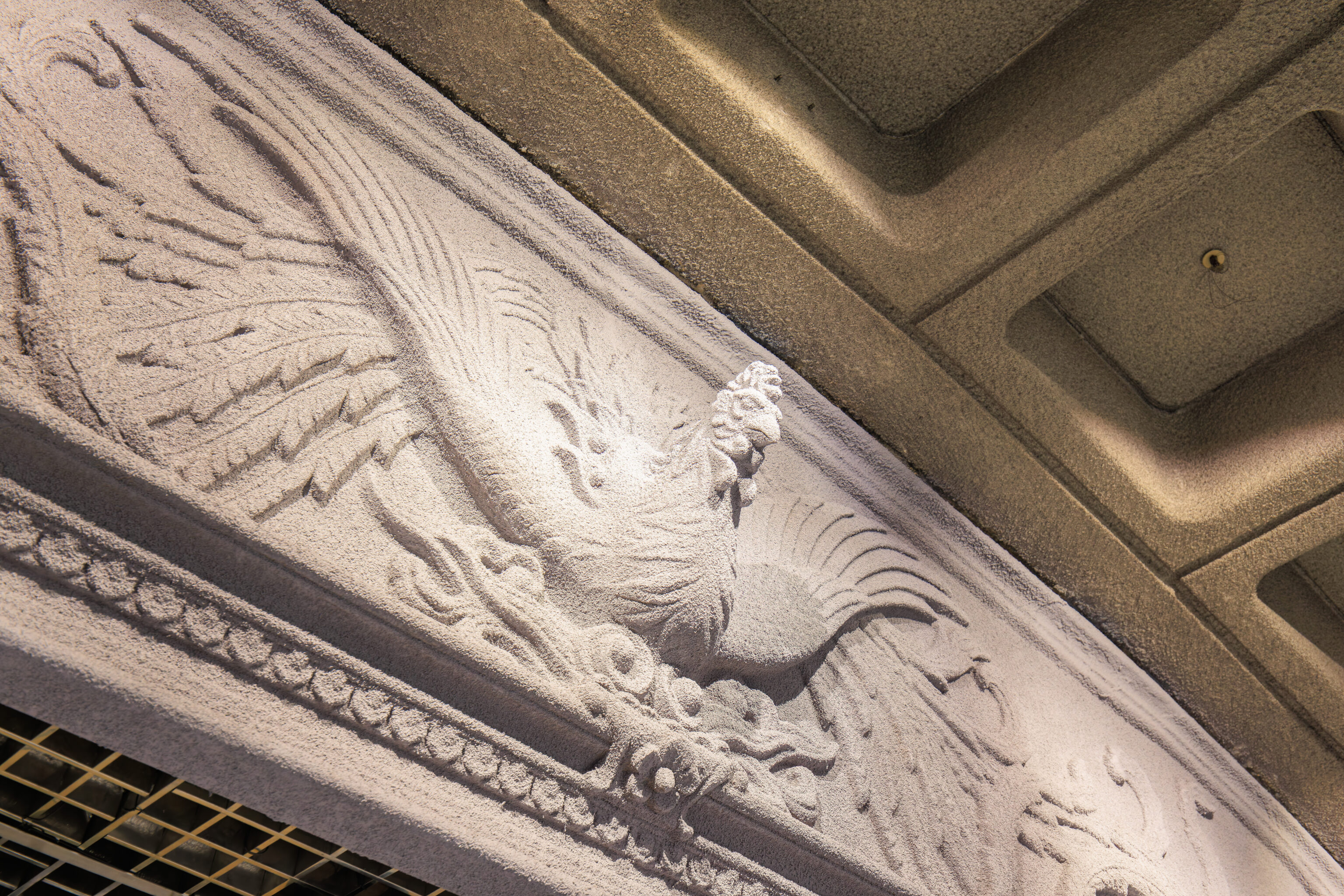
Yesterday, we got off the subway at the City Hall station. Today, we went to the Gyeongbokgung station, the station we left from in the evening yesterday. We were greeted by this phoenix as we exited the station.

We ended up exiting next to the National Palace Museum, on the west side of 용성문 Yongseongmun, the west gate to the courtyard behind Gwanghwamun.
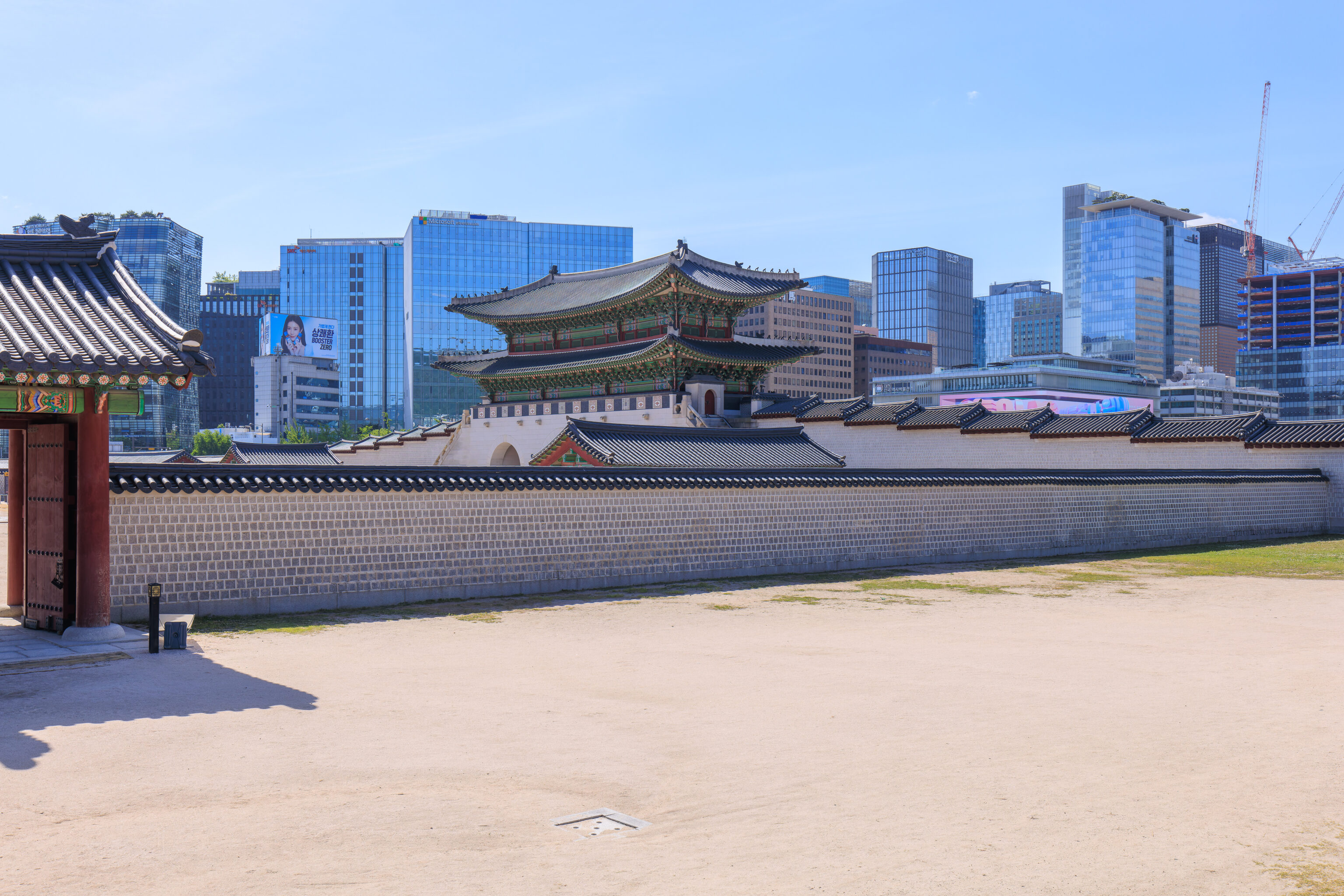
The steps up to the National Palace Museum’s main entrance offer an elevated view. From the top, we could see much of Gwanghwamun.

We walked through Yongseongmun to enter the courtyard to the east. We ended up being pretty early so we had a bit of time to look around. There was still about 45 minutes to go before the guard change at 10am

We went to the middle of the courtyard to get a better view of Gwanghwamun. There was a pretty large group of people by the gate dressed up in hanbok. It turns out that dressing up is quite popular here, seemingly more so than kimono in Japan! May places, including Gyeongbokgung, offer free entry to visitors wearing hanbok, though the entry price is pretty negligible at just a few USD.

Looking to the north, we can see the 흥례문 Heungnyemun, the gate into the ticketed area of Gyeongbokgung. We already spent quite a long time here yesterday so aren’t planning on going in today.

The gate to the west that we just walked through, the Yongseongmun, is much smaller than the bigger gates to the north and south.

Presumably, this roped off drum plays a role in the guard change. Also of note, the large group wearing hanbok in the background getting their photo taken.
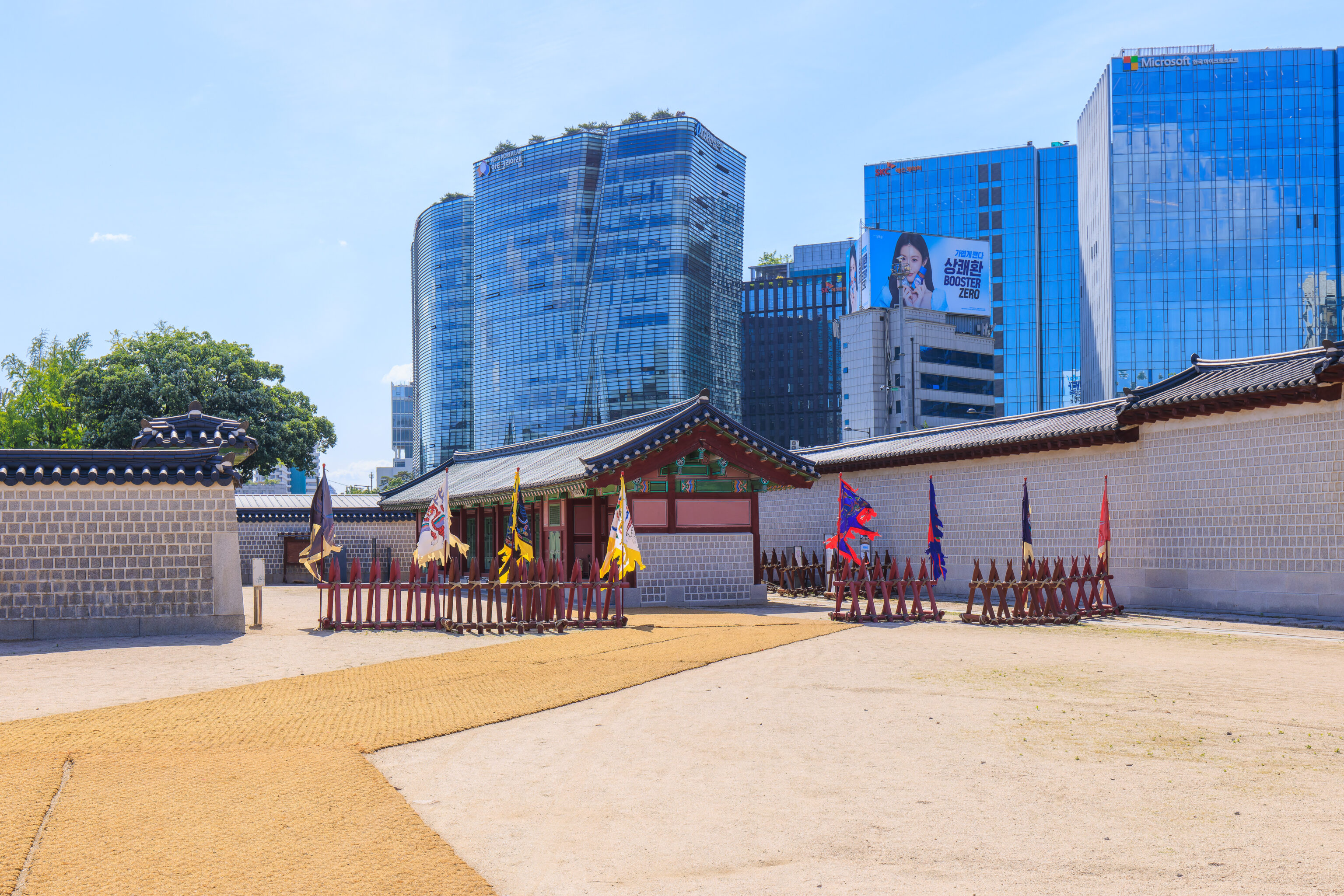
This little section tucked away at the southeast corner of the courtyard didn’t have any people around.


We walked over to Gwanghwamun to take a closer look.

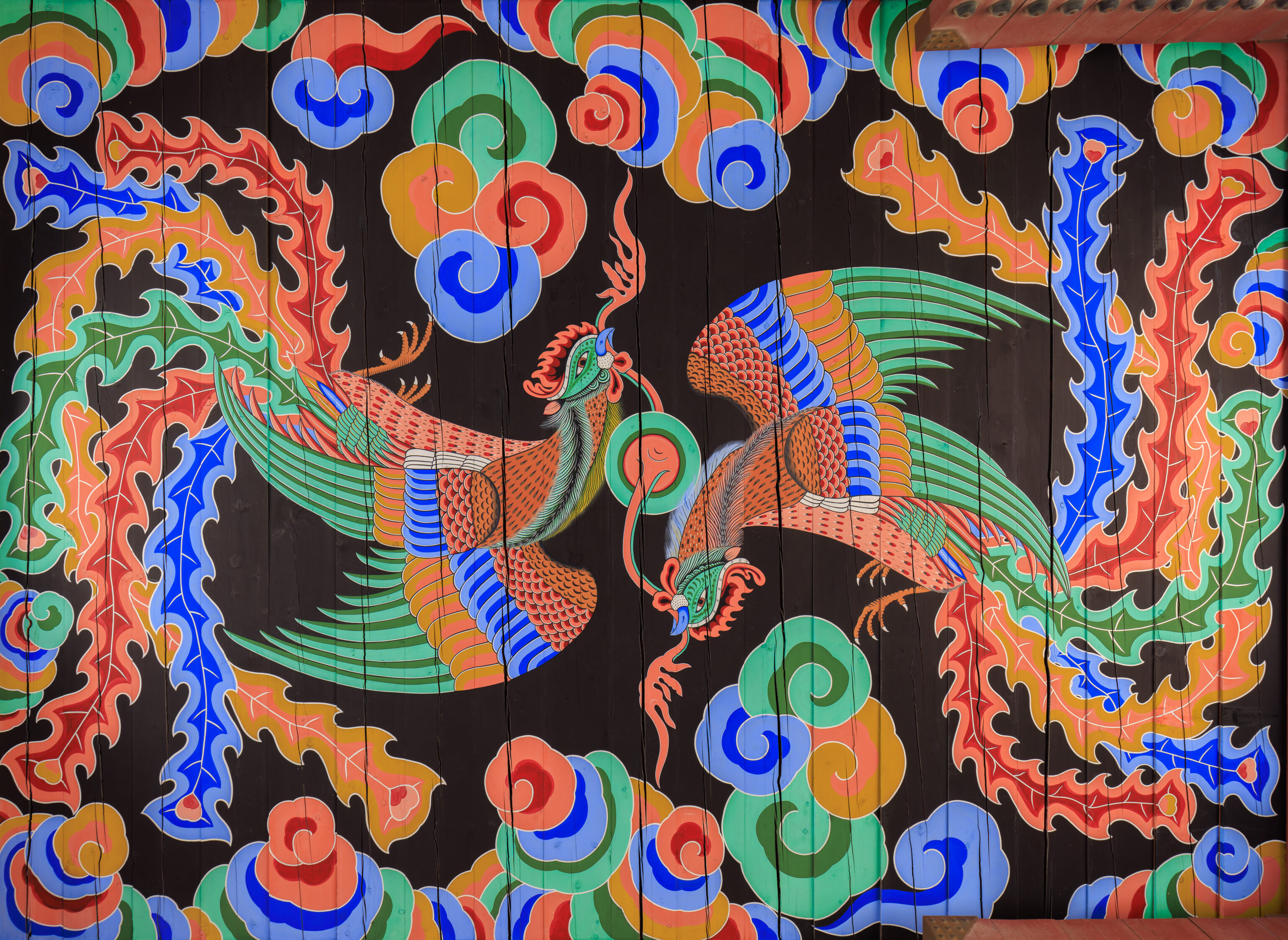
Yesterday, we entered through Gwanghwamun’s eastern gate and took a photo of the painted artwork on the ceiling. Today, we photographed the other two ceilings.

This was the view to the north from the south side of Gwanghwamun’s middle gate. There was a small barrier blocking the way through this gate, requiring visitors to use the east and west gates instead.

We decided to sit and wait under this overhang near Gwanghwamun. It shaded us from the hot sun!

At 9:35 or so, we heard an announcement about guard training which was about to occur! We were a bit late getting there and mostly missed the guards marching to the north on the east side of 협생문 Hyeopsaengmun. We hurried behind them and were able to get a good viewing spot to see whatever was going to happen next.
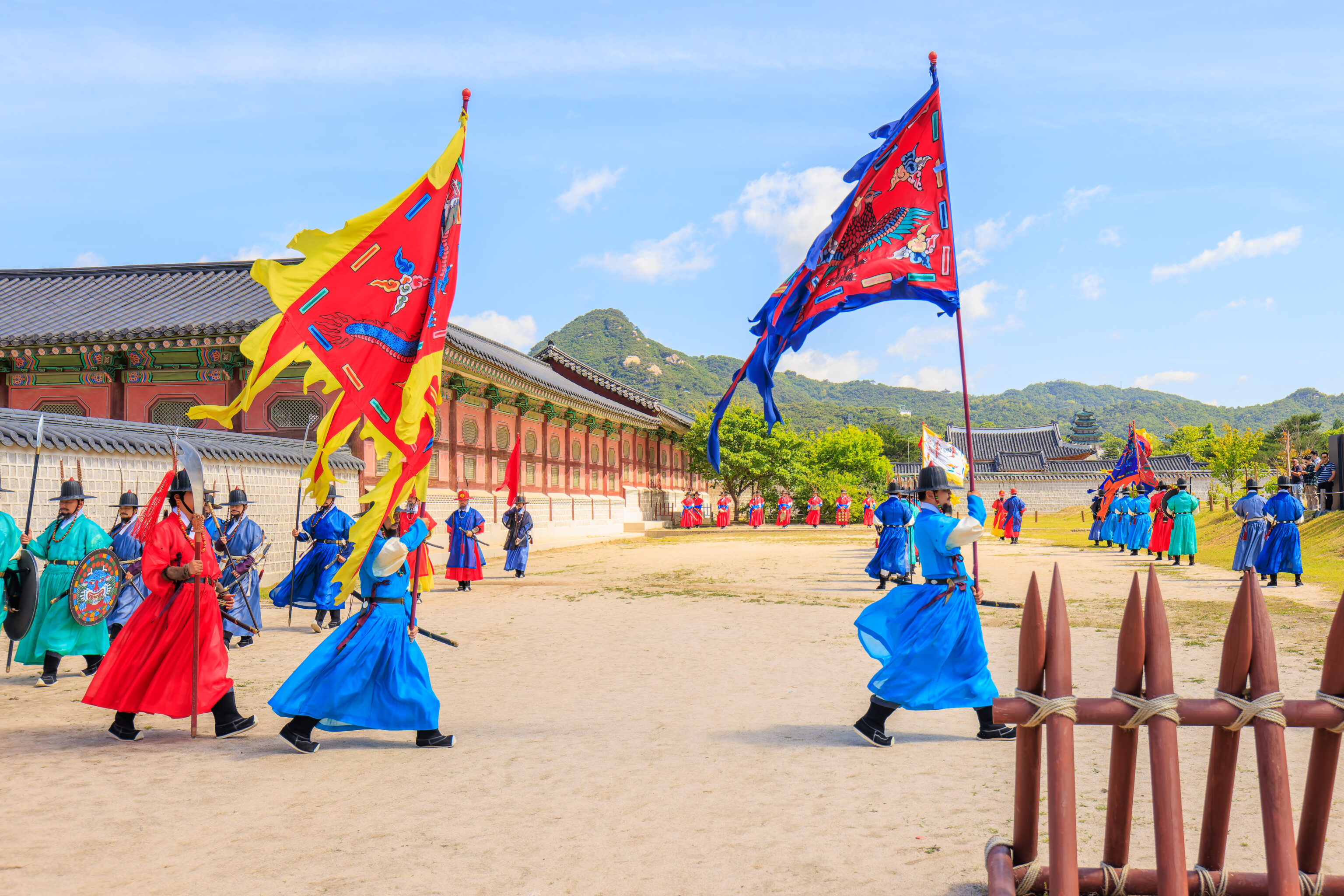

Some of the guards walked around a bit as we observed.
We decided to take some video as it shows what is going on a bit better. The normally dressed guy walking around in the middle of the field seems to be a trainer.
It wasn’t really obvious exactly what was going on.

We also don’t know what the different uniform colors represent.
There was a good amount of mostly standing around. And some flag waving. We took many short clips as the practice session was pretty slow paced.

Some more standing around…
A line of guards began marching away, though they ended up just lining up.
Soon, they marched away for good. The whole thing lasted maybe 10 minutes or so.

We hurried back into the courtyard behind Gwanghwamun to catch the actual guard changing ceremony, which was going to start soon. It was already pretty busy with a large area at the center roped off. We found a spot to stand at the northwest corner.

About 8 minutes later, we saw a line of guards march in.
The guards marched to the center of the courtyard. Narration was provided in Korean, English, Chinese, and Japanese.
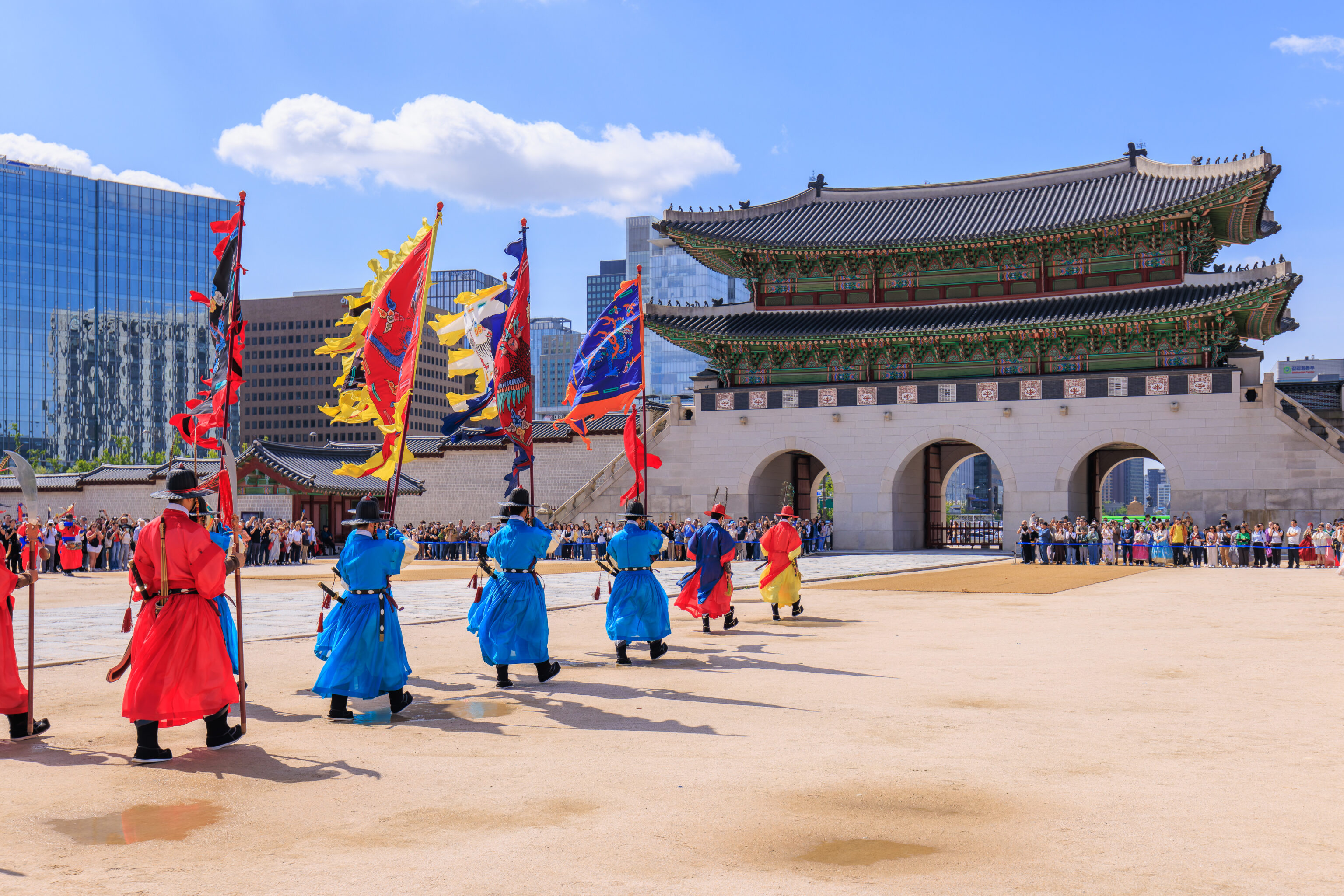
The line of guards turned near us and headed back towards Gwanghwamun.
They stopped in the middle of the courtyard before reaching Gwanghwamun.

They then continued moving to the gate.
The guards lined up near the gate, unfortunately a bit far from us. Soon, we heard the big drum that we saw earlier and eventually heard more instruments as an additional line of guards marched in.

Eventually, there were quite a few guards in the courtyard. They were all pretty far from our corner though!
Some of it was a bit like part of the practice session, but with many more guards.
The guards did end up marching by us though!

The formation of guards ended up near the center of the courtyard.
There was alot of standing around. It must be quite painful in the middle of summer!
Soon, the guards started to march away from us, forming up again near the big drum.

Some guards headed in our direction again.
This was the closest the guards got where they seemed to be doing something. Though, we couldn’t really tell exactly what was going on.
After three gongs of the drum and three blows of a horn, they marched away to the sound of music.

The whole guard changing ceremony took just a bit more than 15 minutes. While interesting to watch at times, we had little idea of what was actually going on!
National Palace Museum
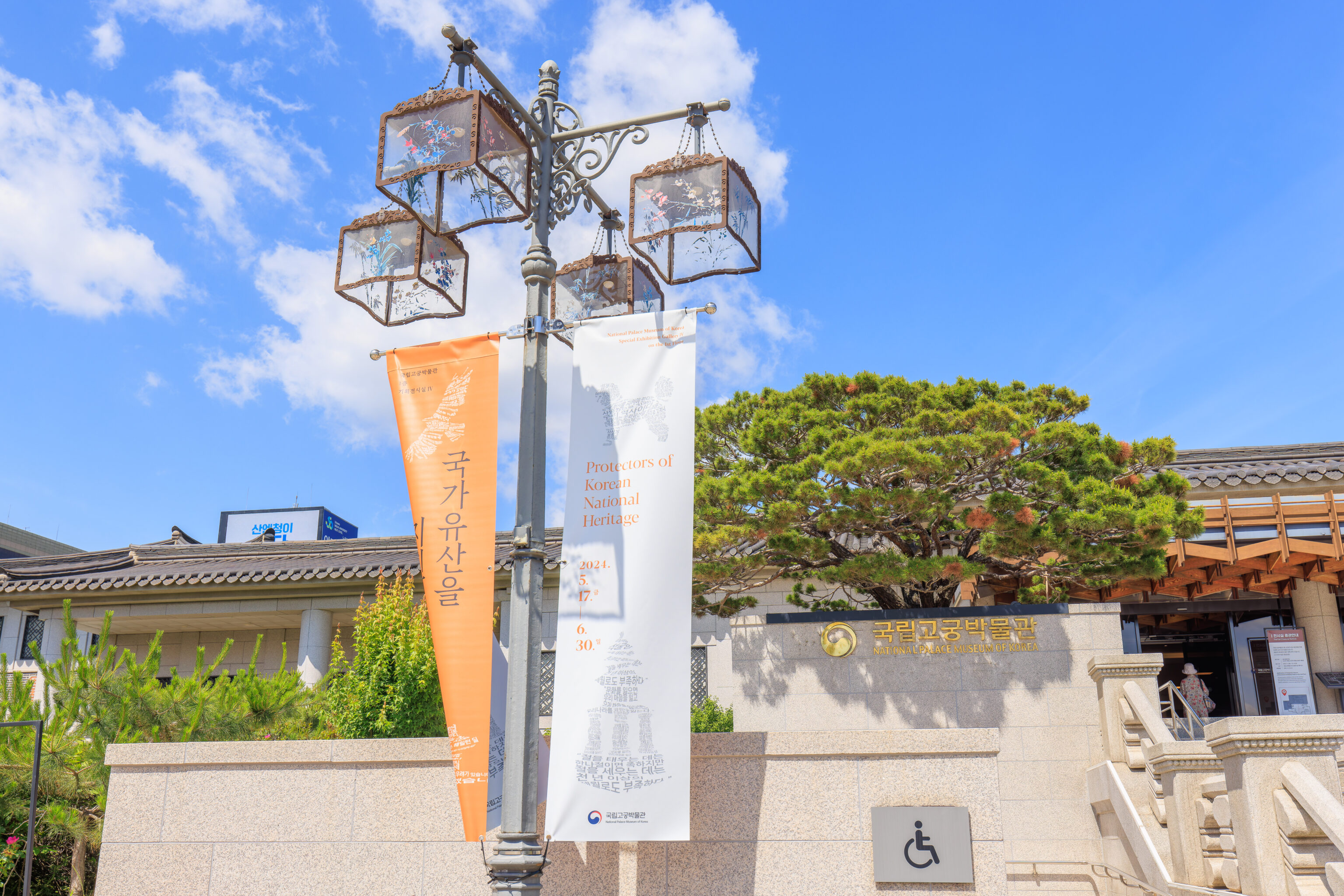
It was only around 10:15am, a bit early for lunch, but a bit late to do much before going to lunch. We decided to visit the National Palace Museum as it was near us, on the other side of the courtyard’s west gate.

We headed up the stairs to enter the museum. The entrance is on the building’s second floor.


We picked up a brochure when we entered. Unfortunately, most of the rooms on the entry floor were closed for renovation. There were still quite a bit of items in the first floor and basement of the museum. We tried to walk through and look at displays that seemed historically important and interesting.
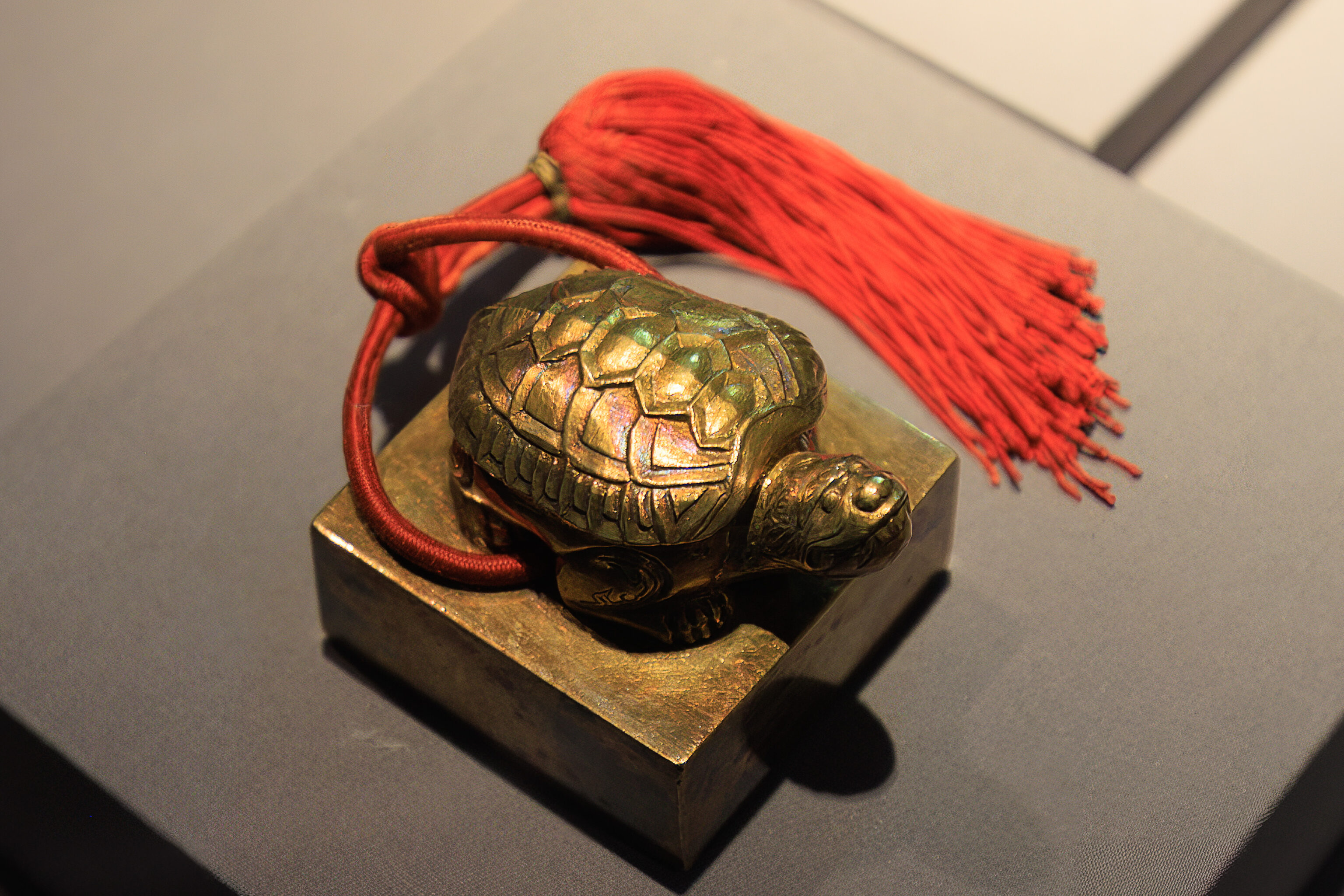
This turtle seal belonged to Emperor Gojong. Although the display had a brief English description, the Korean text is longer and has different information. The Korean text translates to:
This is a box that contains the Great Seal of the Korean Empire and the Great Seal that Emperor Gojong used in his personal letters. The national seal is engraved with ‘Emperor’s seal. As Japan's invasion began in earnest, King Gojong requested support for the Korean Empire through diplomatic relations with neighboring countries. Gojong's personal letters and secret letters written in desperate circumstances at the time are stamped with the Emperor's seal. It shows the urgency of the times and Gojong's active diplomatic efforts for independence
The English text simply states:
This seal was stamped on the personal letter that Emperor Gojong (r. 1863-1907) wrote to denounce Japanese incursions and appeal to international society for support for the Korean Empire.

From left to right, these seals are:
- Seal of the Emperor Jangjo upon His Posthumous Declaration as Emperor
- Seal of the Emperor Jeongjo upon His Posthumous Declaration as Emperor
- Seal of the Emperor Sunjo upon His Posthumous Declaration as Emperor
- Seal of the Emperor Munjo upon His Posthumous Declaration as Emperor
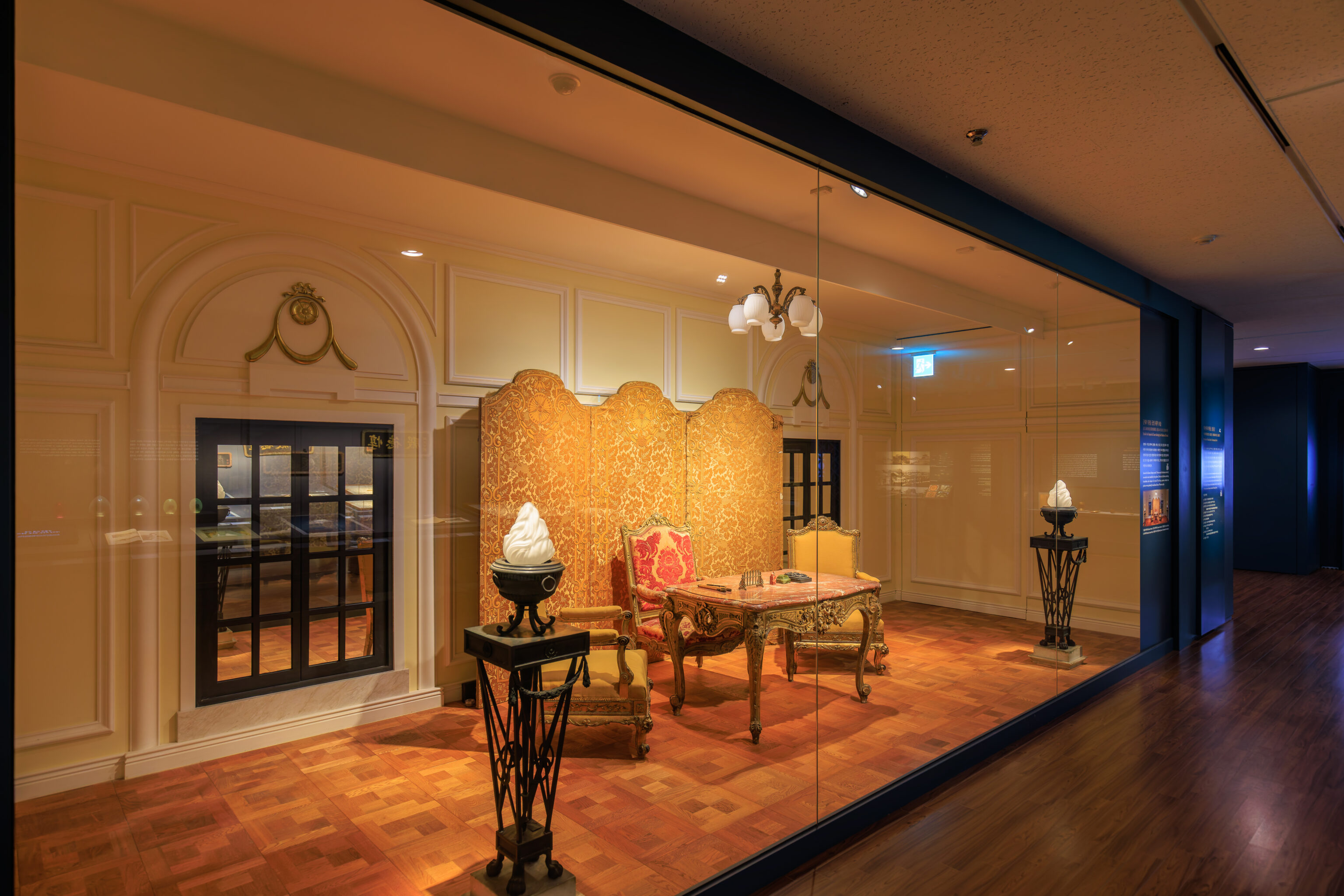
This display showed a Western-style room. The sign describing this room has both English and Korean text. The content is similar but the Korean text has slightly more detail. It translates to:
Around the Korean Empire period, Western-style furniture and decorative items imported from France, England, China, and Japan were introduced to the palace. Most of these furniture and household items are decorated with plum flower patterns, a symbol of the imperial family of the Korean Empire. Additionally, as electrical facilities such as chandeliers began to be used, the living spaces at Deoksugung Palace and Changdeokgung Palace gradually transformed into Western styles.

This display contains the Yellow Throne, dating back to 1902. A sign describes this throne in Korean, translated to English:
The throne is the chair on which the emperor or king sits. It is also called a throne or a throne. Unlike the throne during the Joseon Dynasty, which was red, during the Korean Empire, it was painted yellow to symbolize the emperor. The front of the body is decorated with a dragon pattern, and gold dragon heads are placed at each corner.
The second sentence ends up being redundant in English as whatever the words are in Korean, they both translate to throne in this context.

This large room contained a wide projection screen. It shows an imperial procession. It seems it is of King Jeongjo on the 1795 Eight Days Parade.
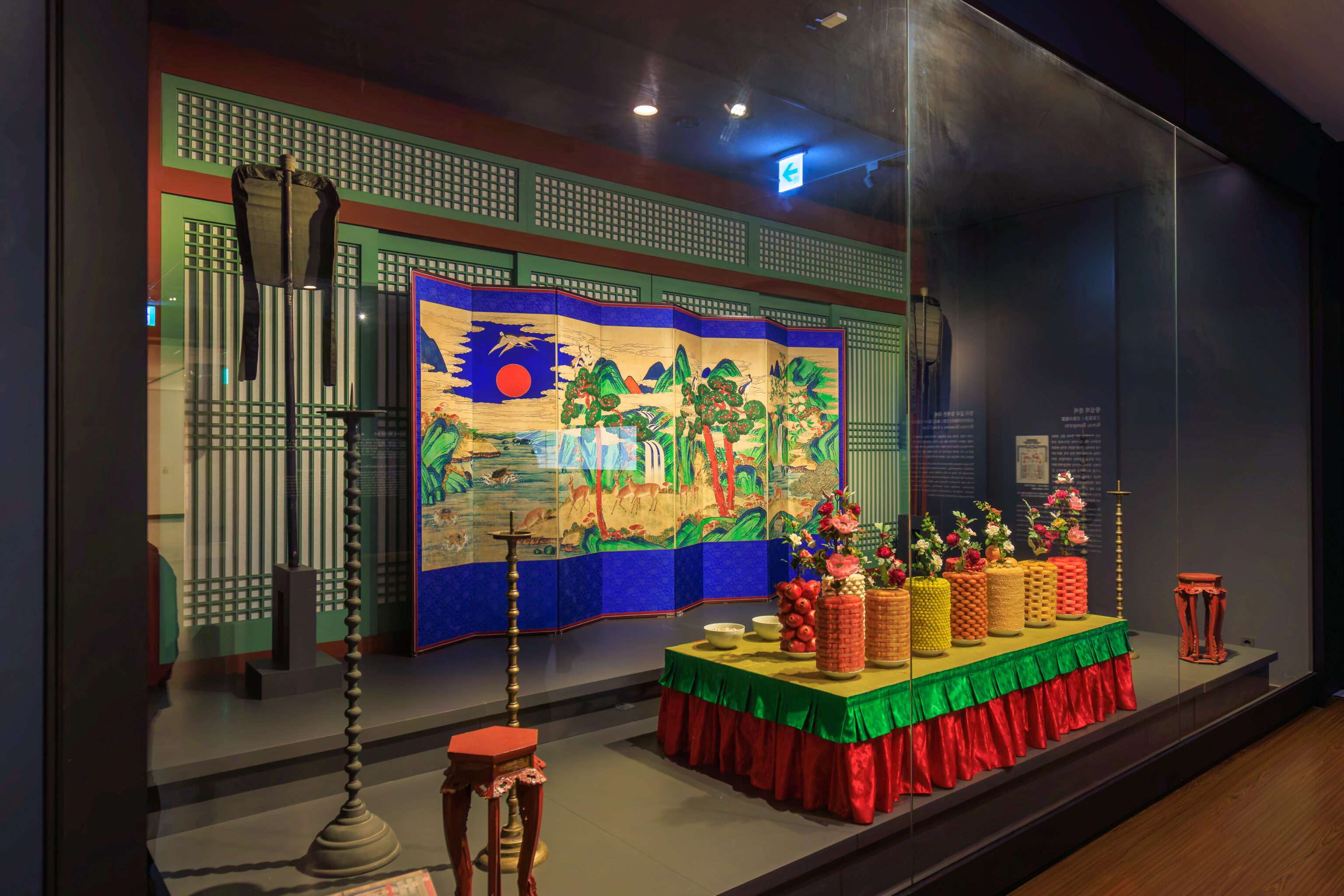
We didn’t photograph the sign here, however, this display seems to show funeral offerings.

This jade seal is from the Joseon Dynasty in 1696.
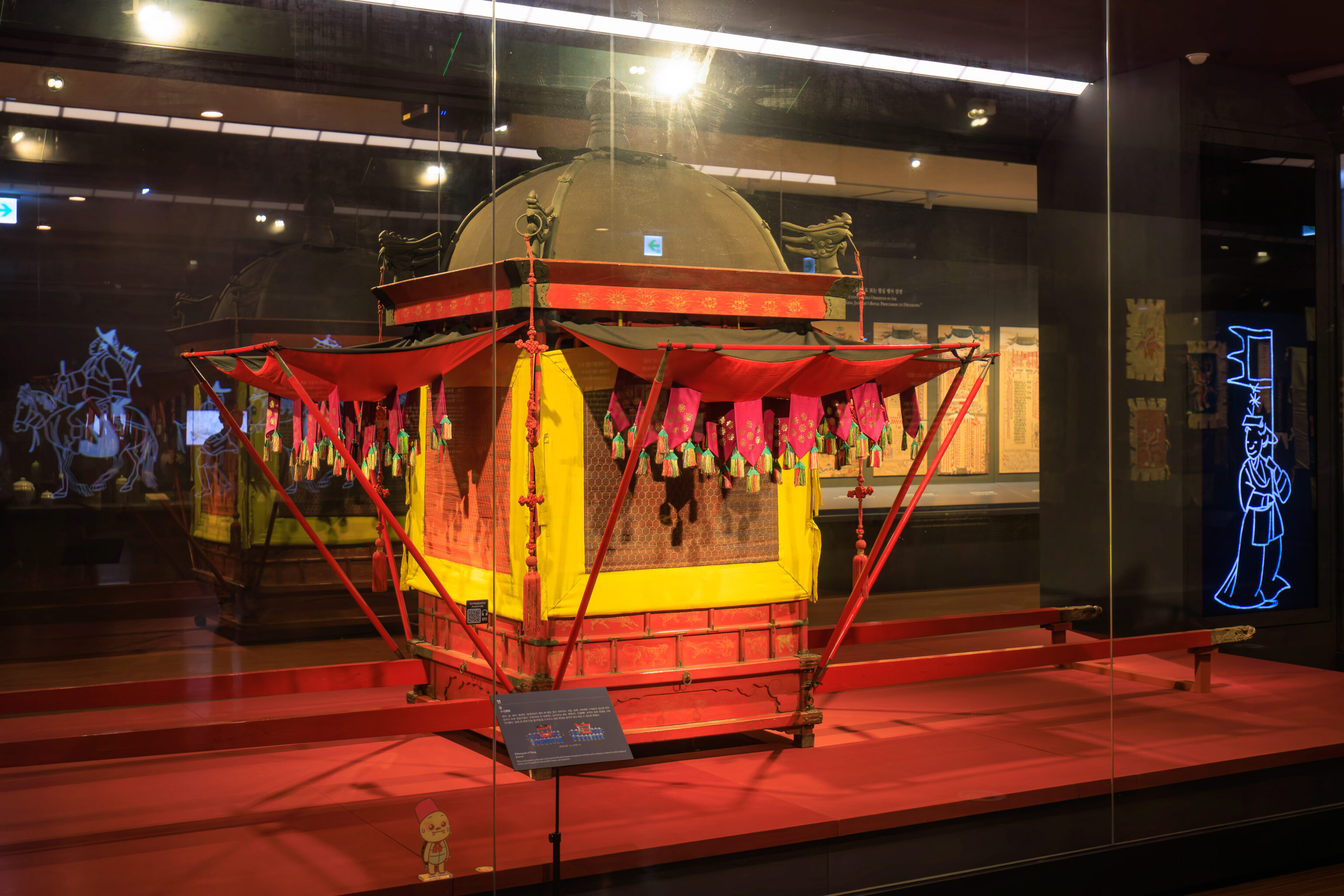

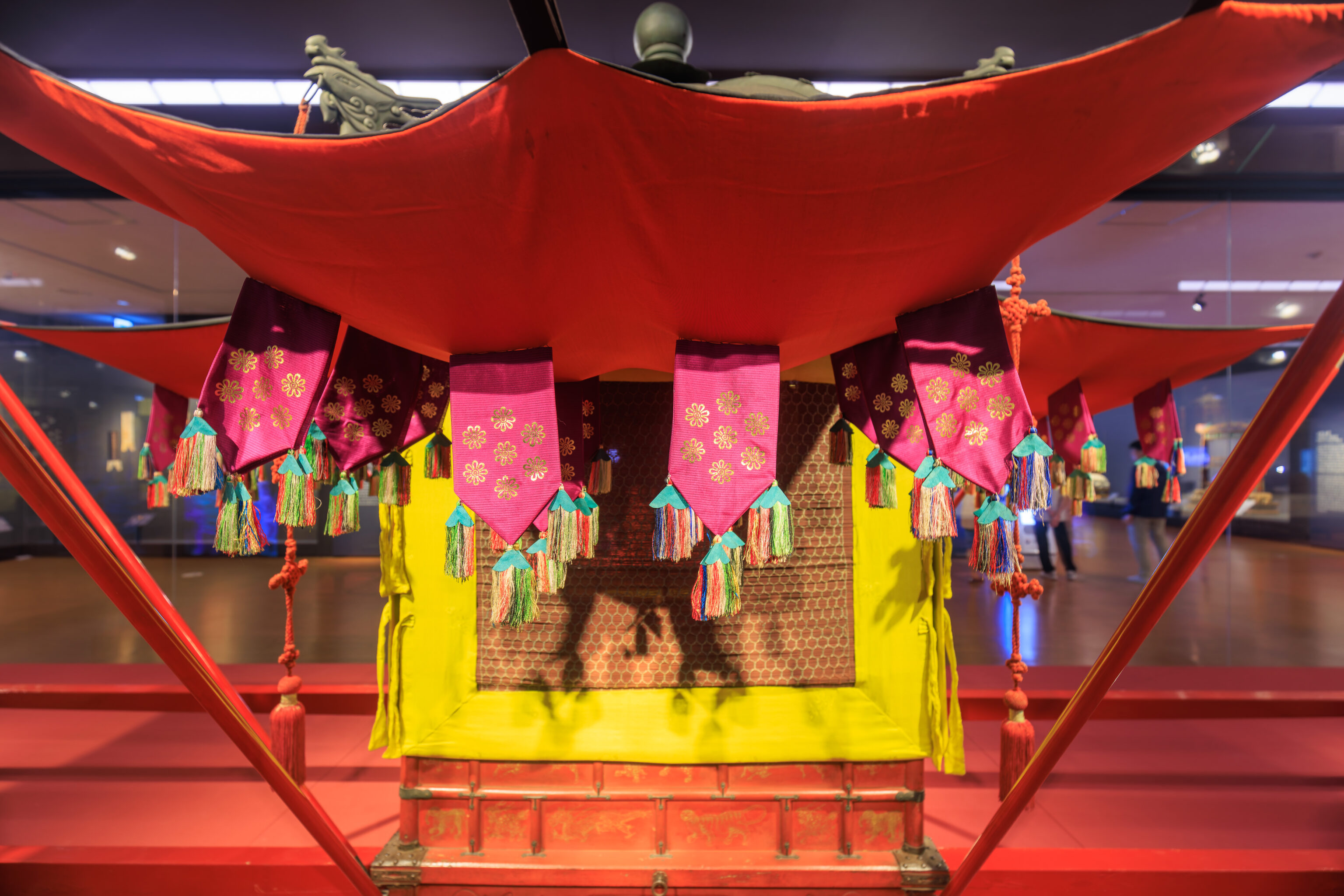
This carriage, which is lifted by two columns of men, is referred to as a palanquin in English. It is described on a sign in Korean, translated to English:
It is a formal palanquin that the Queen Mother, the King, the Queen, the Crown Prince, and the Crown Princess rode on when they went on parade. It consists of a roof, body, and palanquin, each of which is made to be separate. The body, covered in vermilion lacquer, was decorated with patterns such as a dragon, a white beetle, a giraffe, and an elephant using gold ink. Beaded feet [juryeom] were draped on four sides of the body, and black curtains were attached so that they could be opened and closed.
The English descriptions offers a slightly different description of the animals depicted:
This red-lacquered palanquin is decorated with gold designs of auspicious animals, such as dragons, baektaek (a white mythical beast), girin (a mythical unicorn-like beast), and elephants.
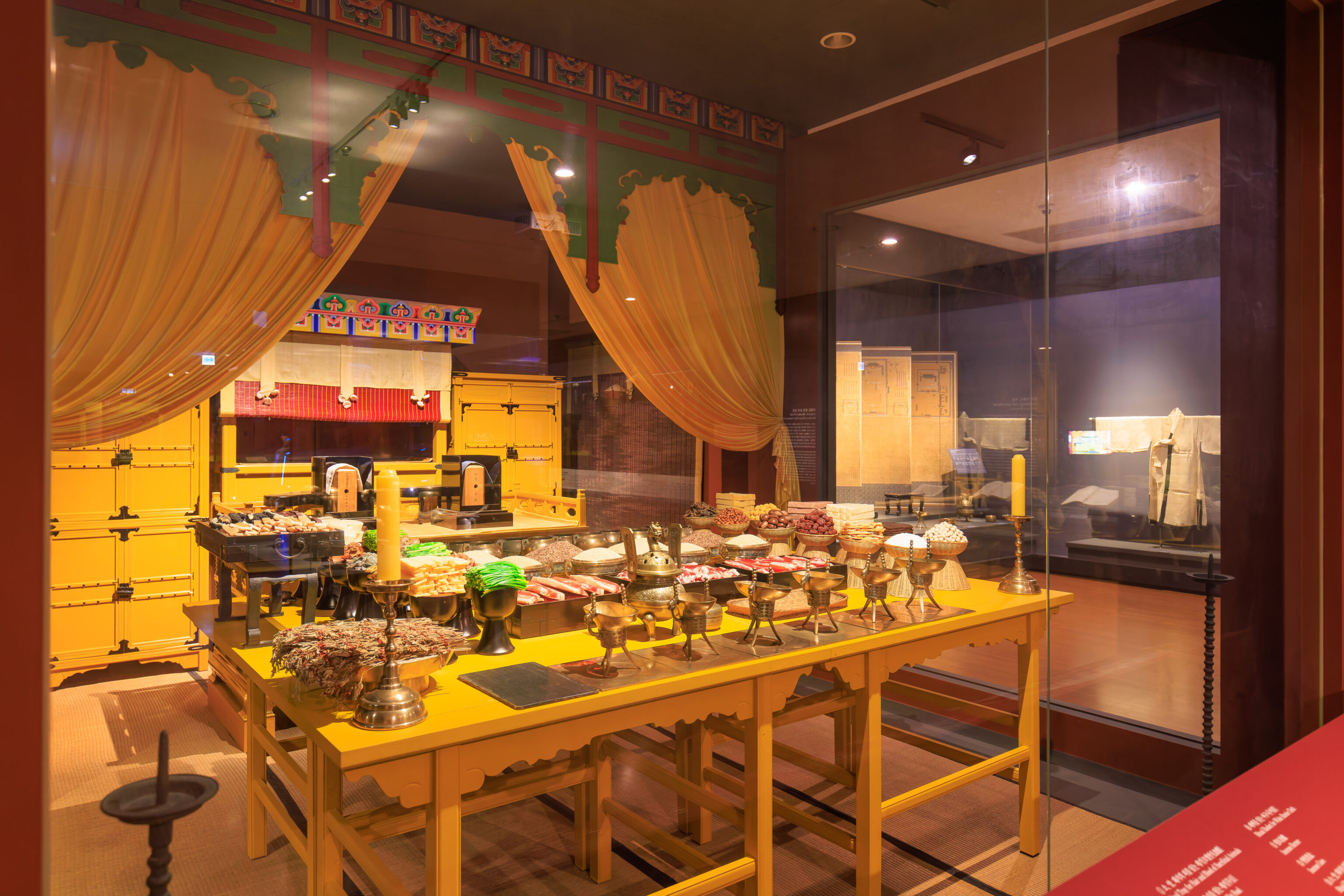
This display shows more food offerings.
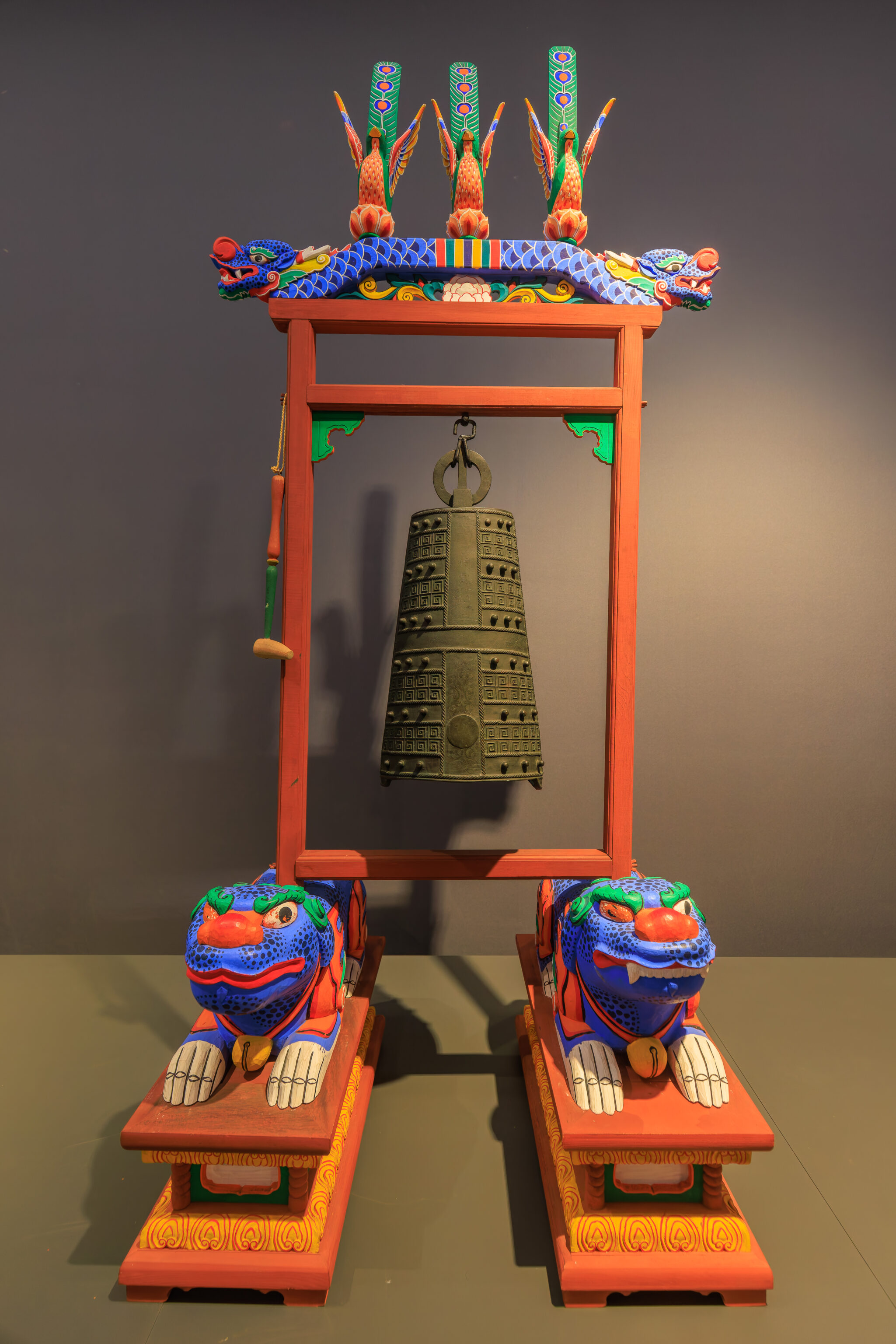


Two interesting items in the museum’s collection.

This looks like the sundial that we saw yesterday at Gwanghwamun Square. Korean text on an adjacent related display provides a description, translated to English:
It is a sundial that shows the daytime through the sun's shadow. There are horizontal and vertical lines on the bowl-like concave bowl, and the names of times and walks are engraved on the rim of the bowl. There is a triangular pyramid-shaped stick fixed inside the bowl. You can check the solar terms by following the horizontal line at the location where the picture of this stick is created, and you can check the time by following the new line.
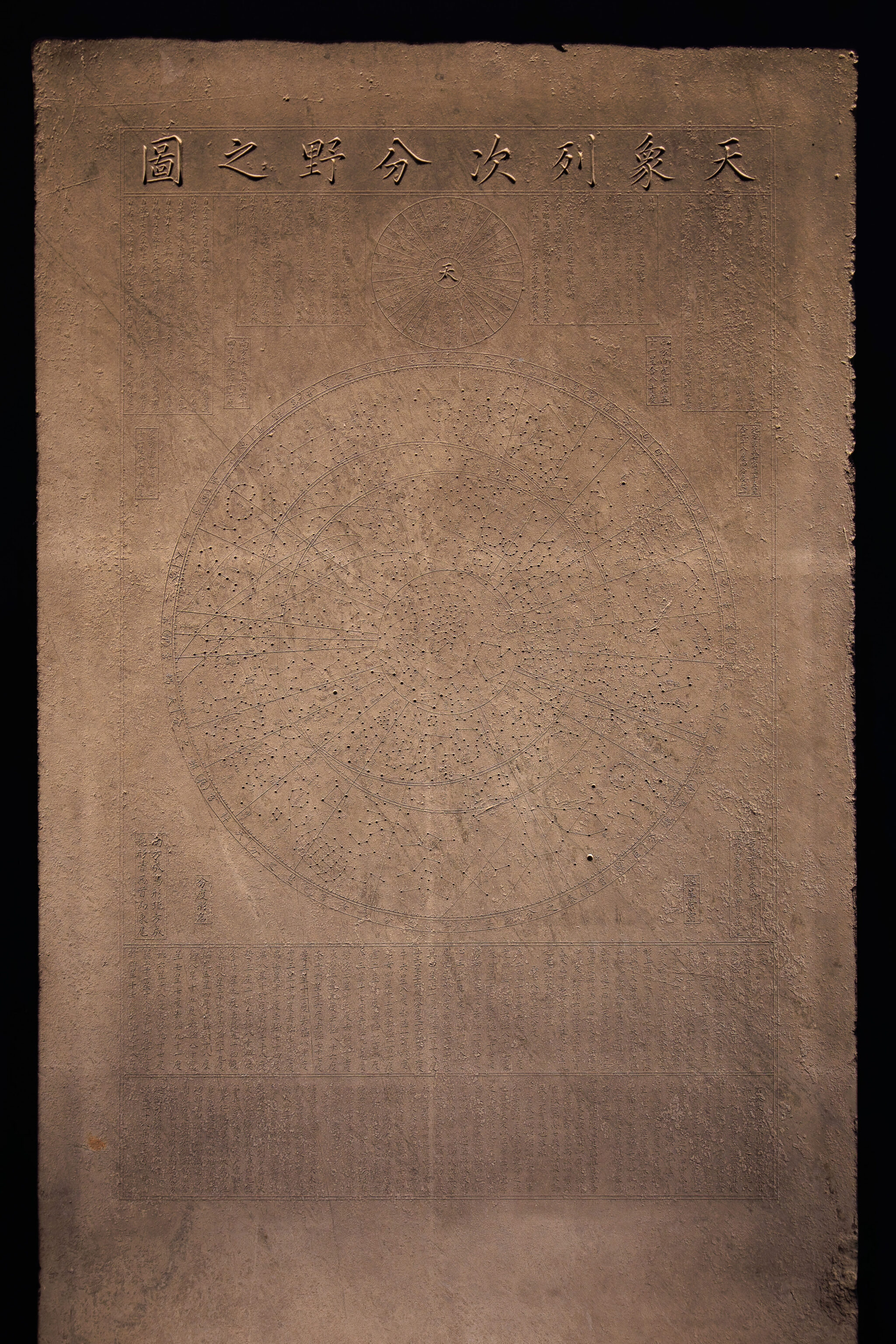
The final room we visited had two large stone tablets. This one is a constellation chart form 1687.

This stone tablet, even older, is from 1395.

The final room that we walked by was this one, described as Open Storage.












The museum had an interesting feature, ink stamps, each featuring a highlight of the museum’s collection. A small informational sheet, something like a bookmark, was provided for each stamp. We could not collect them all due to some areas being closed for renovation.

We spent about an hour and a half in the museum before exiting.
Lunch
By now, it was almost noon. Time for lunch! We decided to try a Korean fried chicken restaurant that we found yesterday while looking for places to eat in the area.
As we crossed the street at the intersection at the southwest corner of the museum, we spotted quite a few police in the area, including in the street. The setup seemed quite familiar. A motorcade was imminent.

We saw a black sedan with Japanese flags as well as multiple black SUVs. There was a meeting today between the leaders of South Korea, Japan, and China. We think this might be Prime Minister Fumio Kishida’s motorcade.

We ended up walking a few blocks to reach 효도치킨 Hyodo Chicken. The location is right next to the main office building of the Seoul Metropolitan Police. The restaurant entrance is not obvious at all as nothing on the outside indicates that it is a chicken restaurant for those who don’t read Korean. The main dining area is on the second floor so it isn’t possible to tell by looking through the windows from the ground floor.
We ordered one dish, which ended up being a good sized portion. We think it was probably one chicken. Interestingly, this restaurant had fried lotus root, which came with the chicken flavor that we ordered. Despite its appearance, it wasn’t as spicy as the chicken from yesterday. And once again, not too sweet like it often is in the US.
Jogyesa
We decided to head over to 조계사 Jogyesa, a Buddhist temple, next. We were perhaps 500 or so feet away from Gyeongbokgung’s southwest corner, Jogyesa is about 500 feet away from Gyeongbokgung’s southeast corner. So, we started walking to the east.

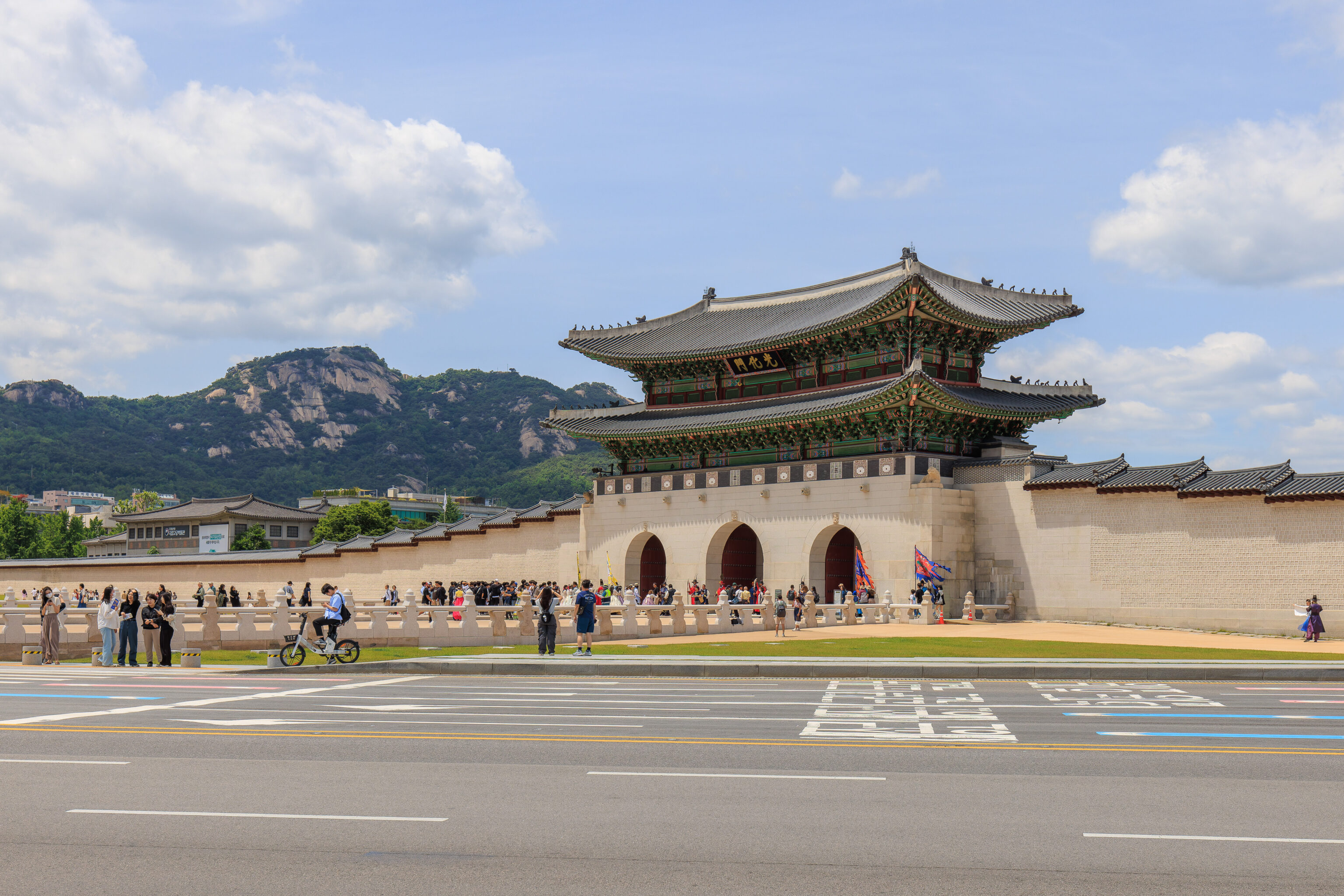
We walked past Gwanghwamun on the way.
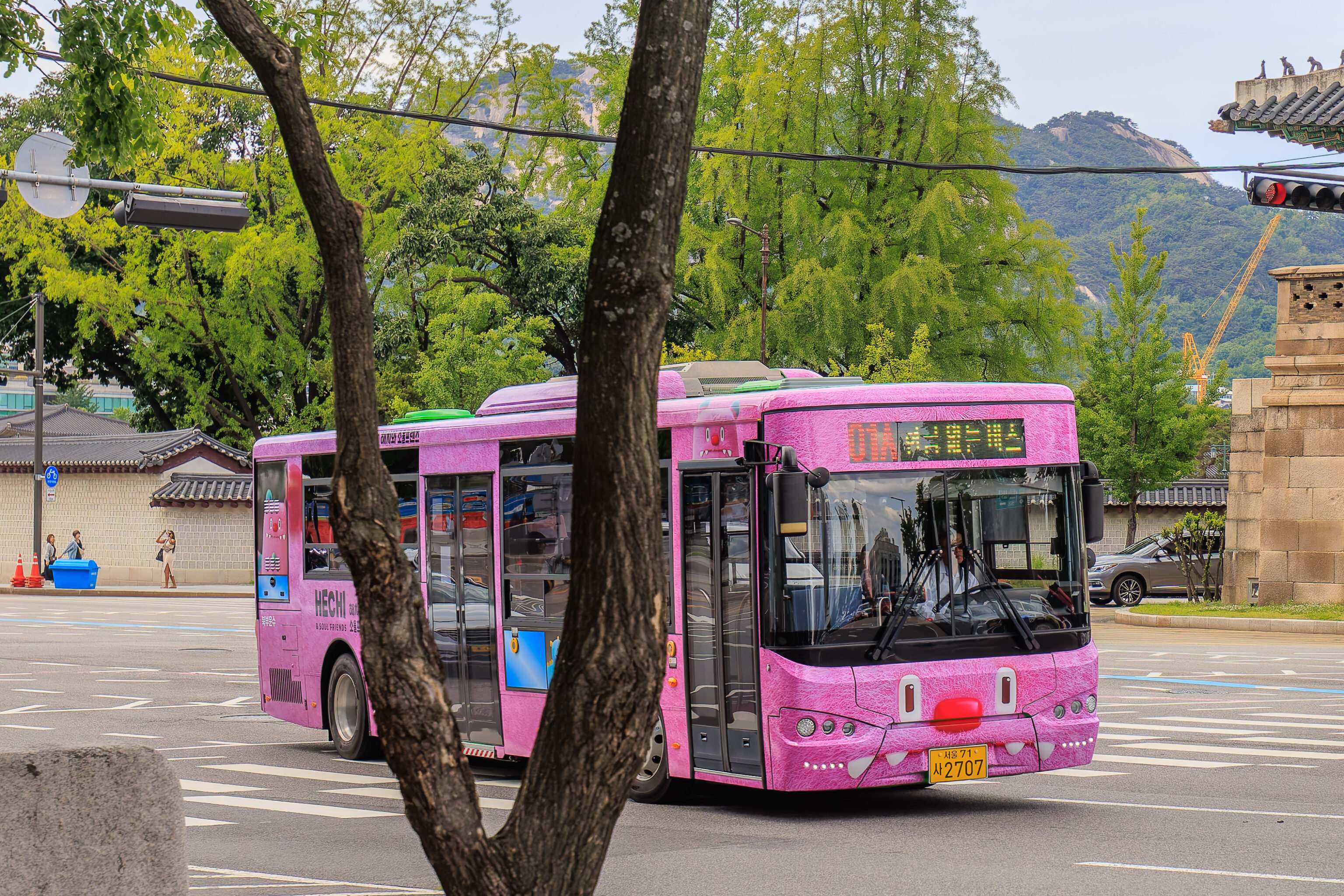
We noticed these pink busses with a cute monster face on the front! They seemed to pass by every few minutes.

Soon, we reached this building. It is near the temple and looks like a temple building. But, it is not! It is the former Central Post Office of Seoul, built in 1884.
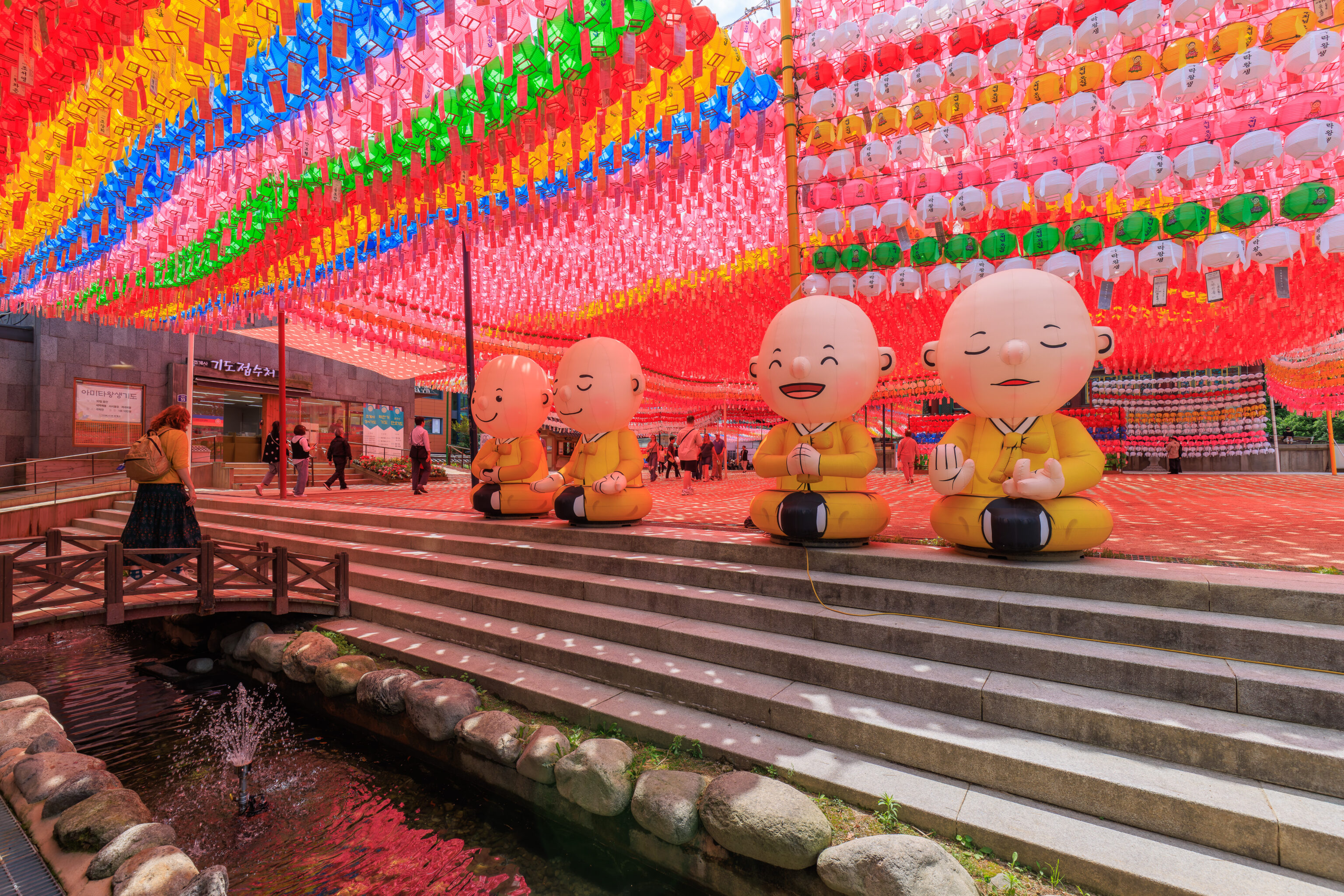
We walked through a small parking lot to reach Jogyesa. We were greeted by four large monks sitting next to a water feature, complete with fountain and bridge! Colorful lanterns hung above, strongly illuminated by the bright early afternoon sun.

looking up, we could see colorful artwork.
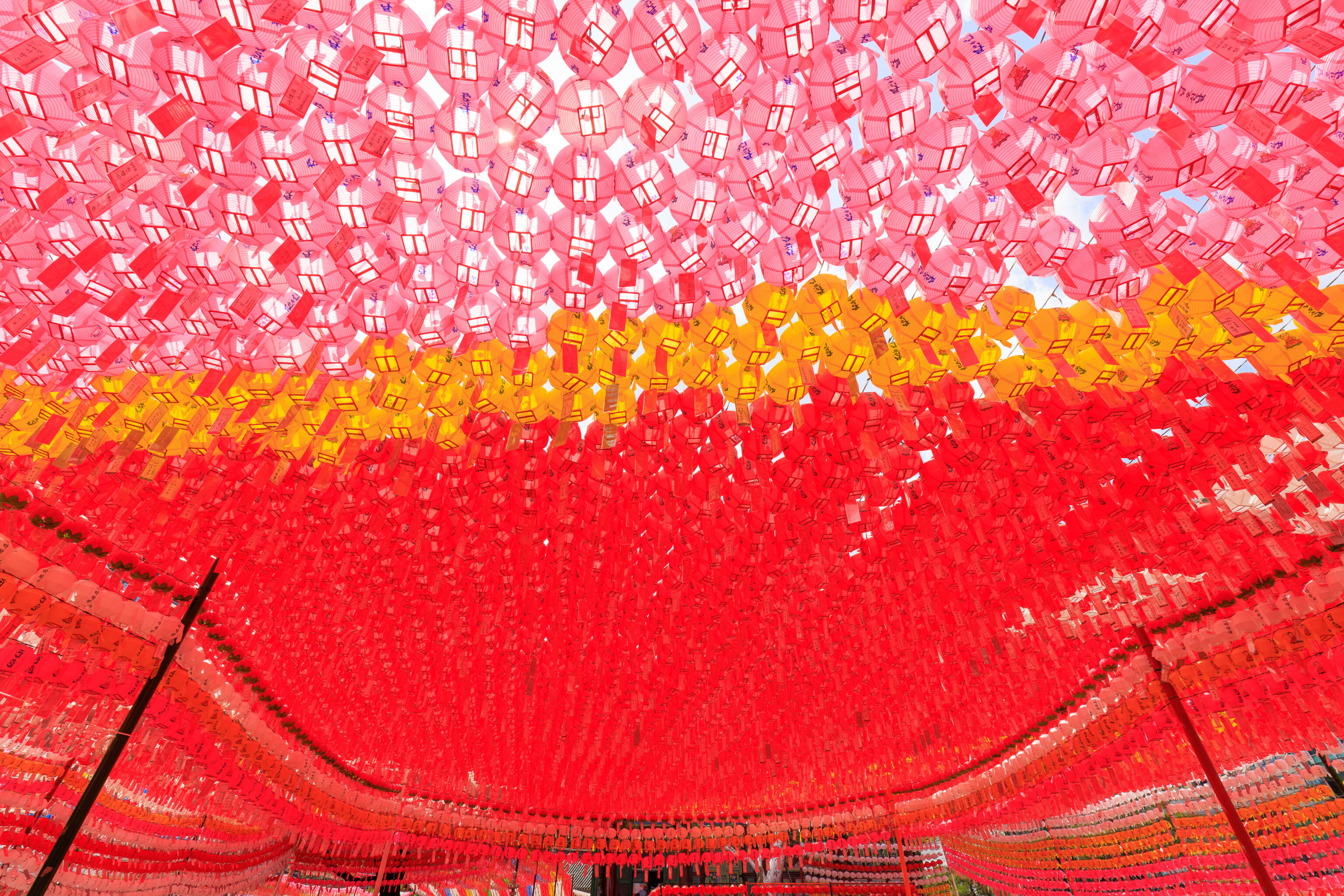

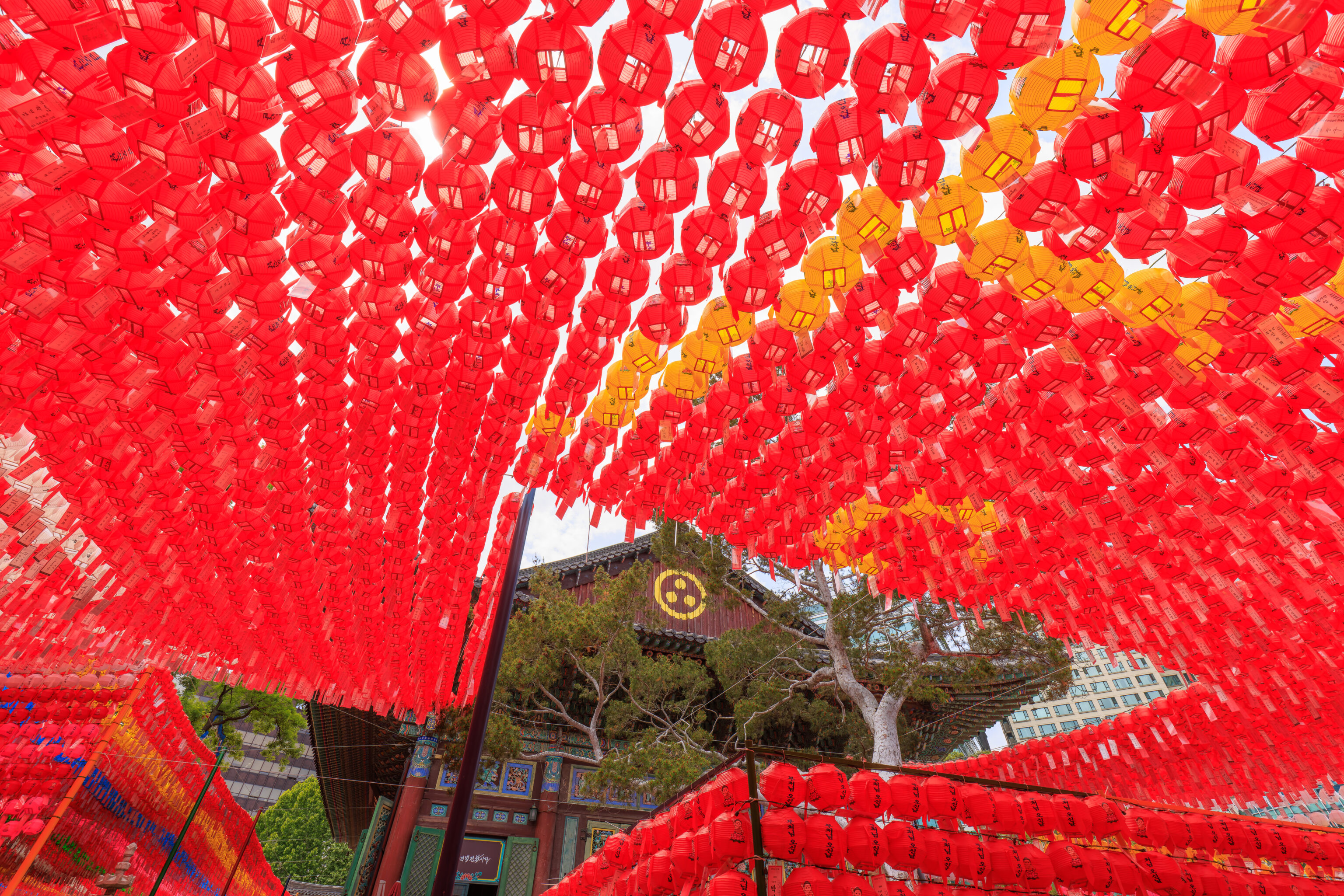
The lantern canopy is quite extensive!
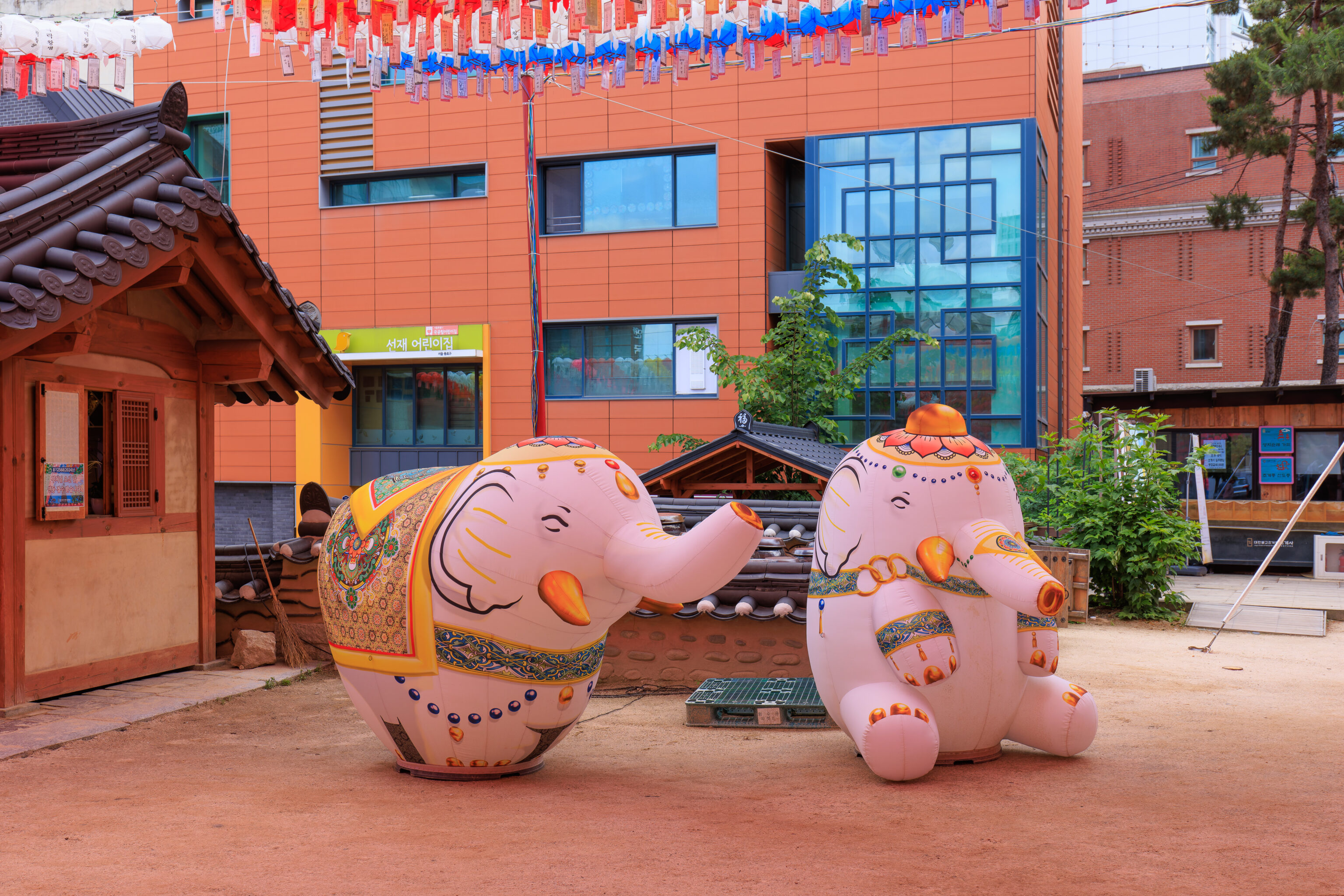
We noticed two elephants on the southern end of the temple.

Another feature of the temple, electronic donation devices! So modern!

The canopy next to the temple’s main building was particularly colorful and completely blocked the large tree’s leaves from view!

We went up to the temple building to take a look. Monks were actively chanting and many people were inside praying. It was possible to go in but we did not as it seemed too crowded with people actually worshiping.

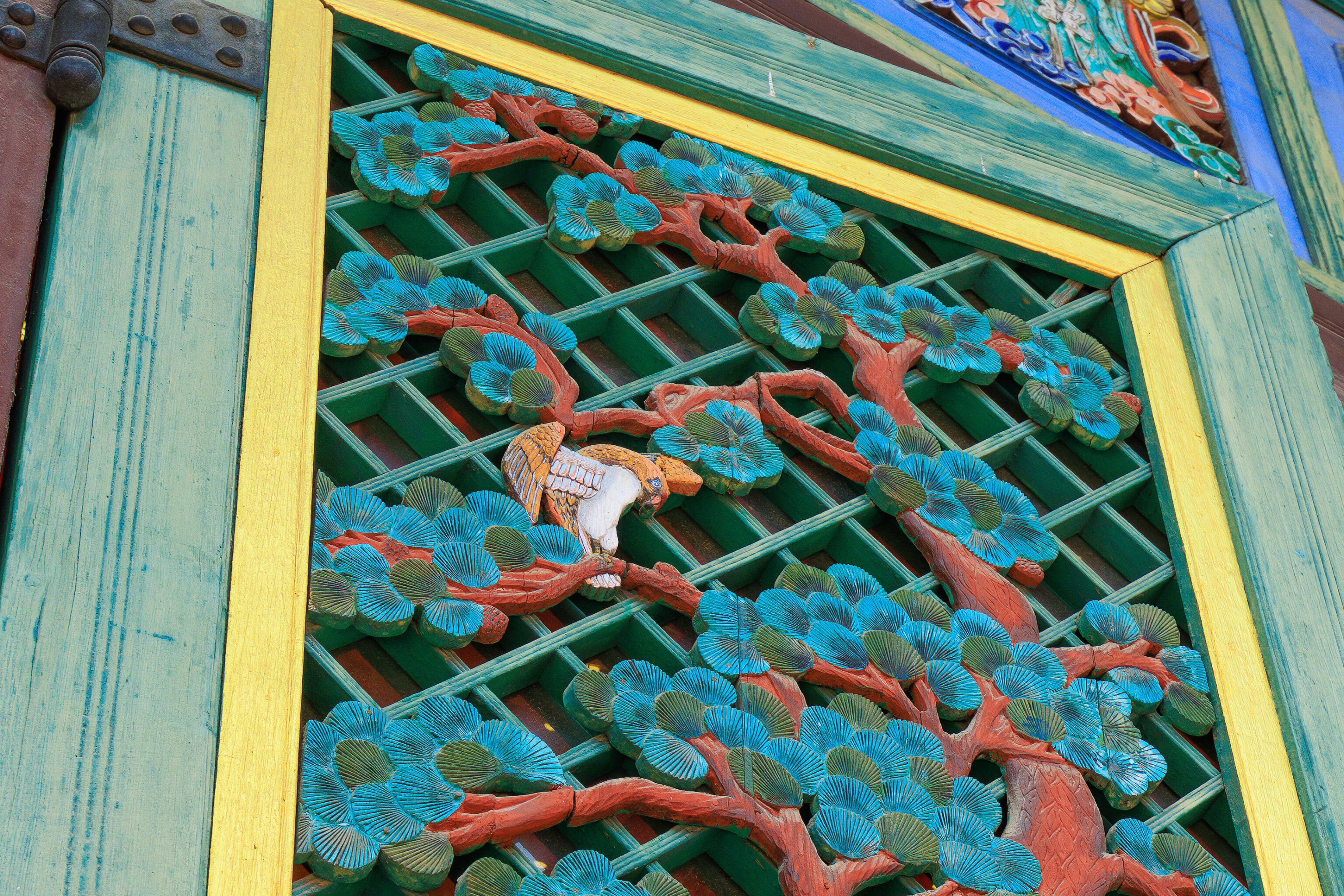

The doors to the temple were beautifully decorated.

Many people were seated in front of the temple building, enjoying the afternoon in the shade.

We walked back to ground level on the west side of the temple building. There were many small lanterns here, organized in a diagonal pattern.

A dragon was clutching the moon!
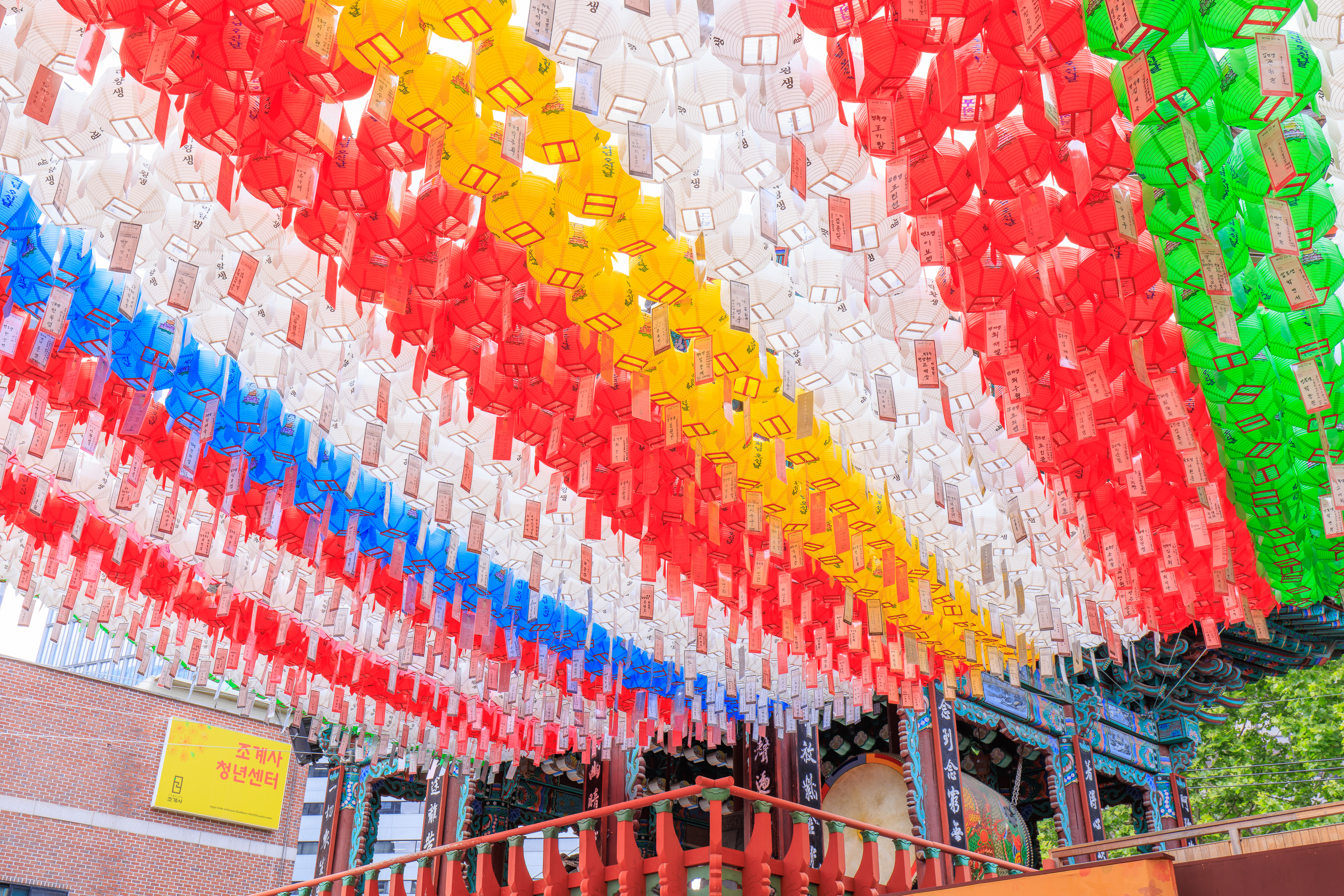
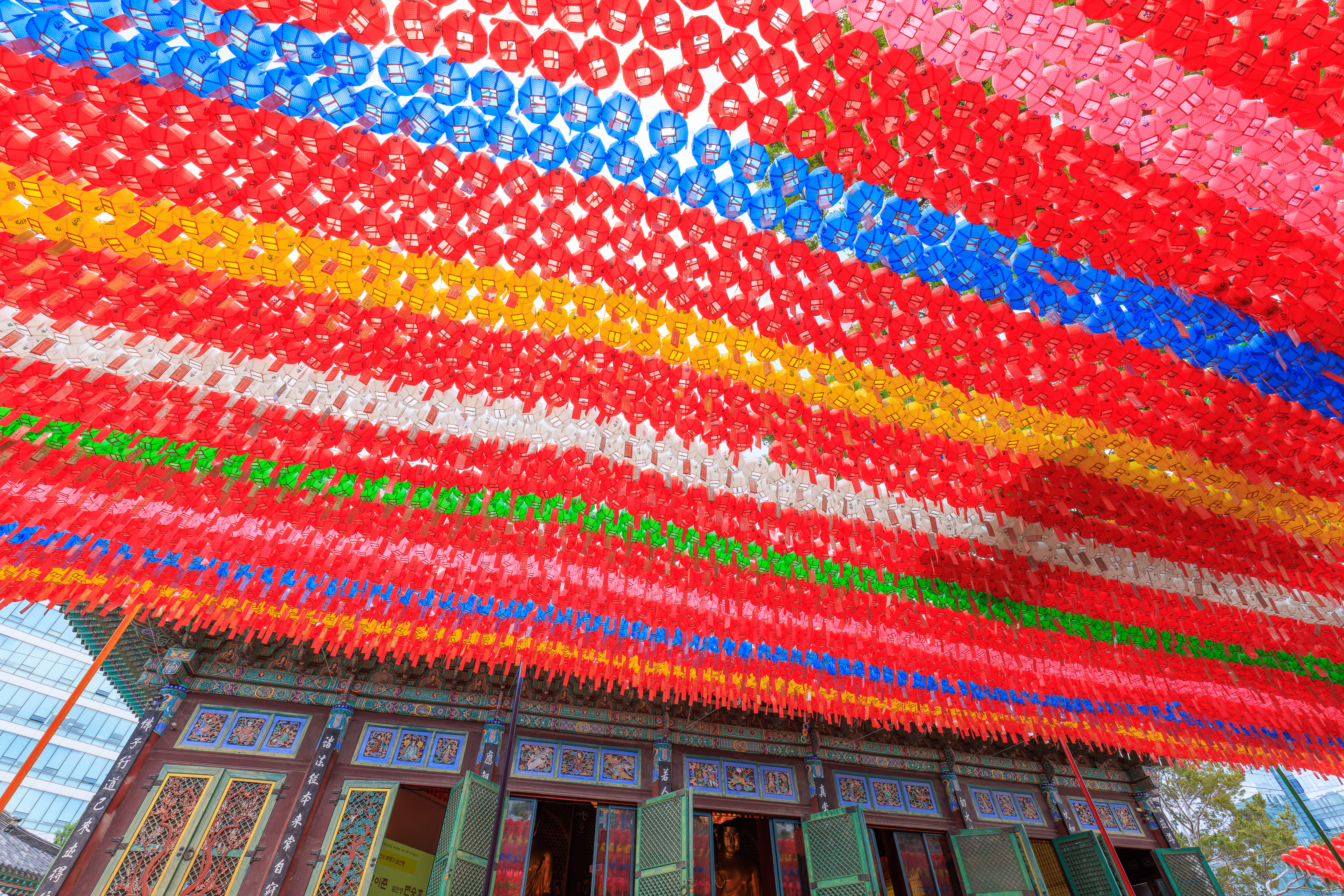
We went to the area in front of the temple’s main hall to sit in chairs like all the other people we saw earlier.
We sat for awhile, listening to the rhythmic chanting of the monks and enjoying the shade.
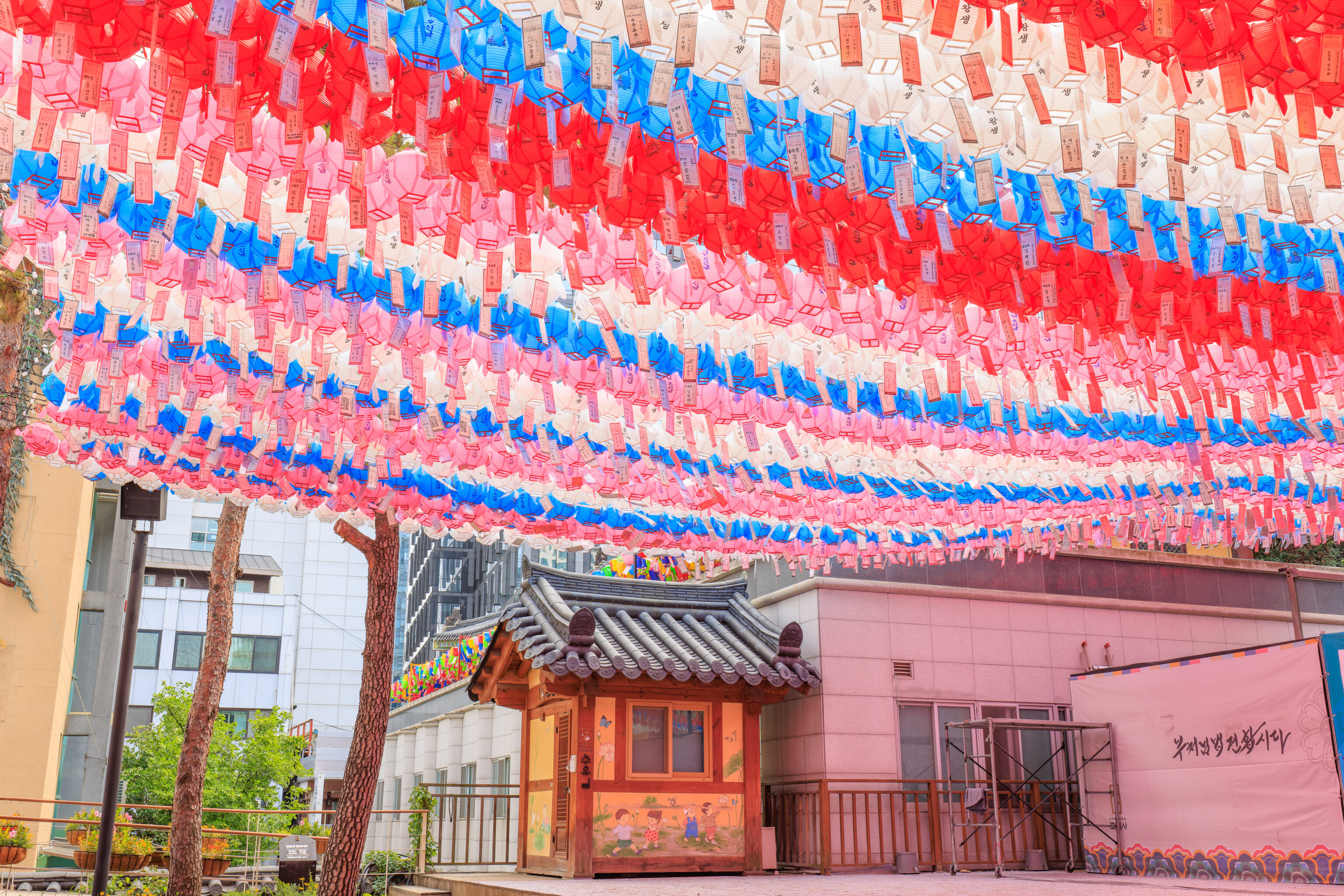
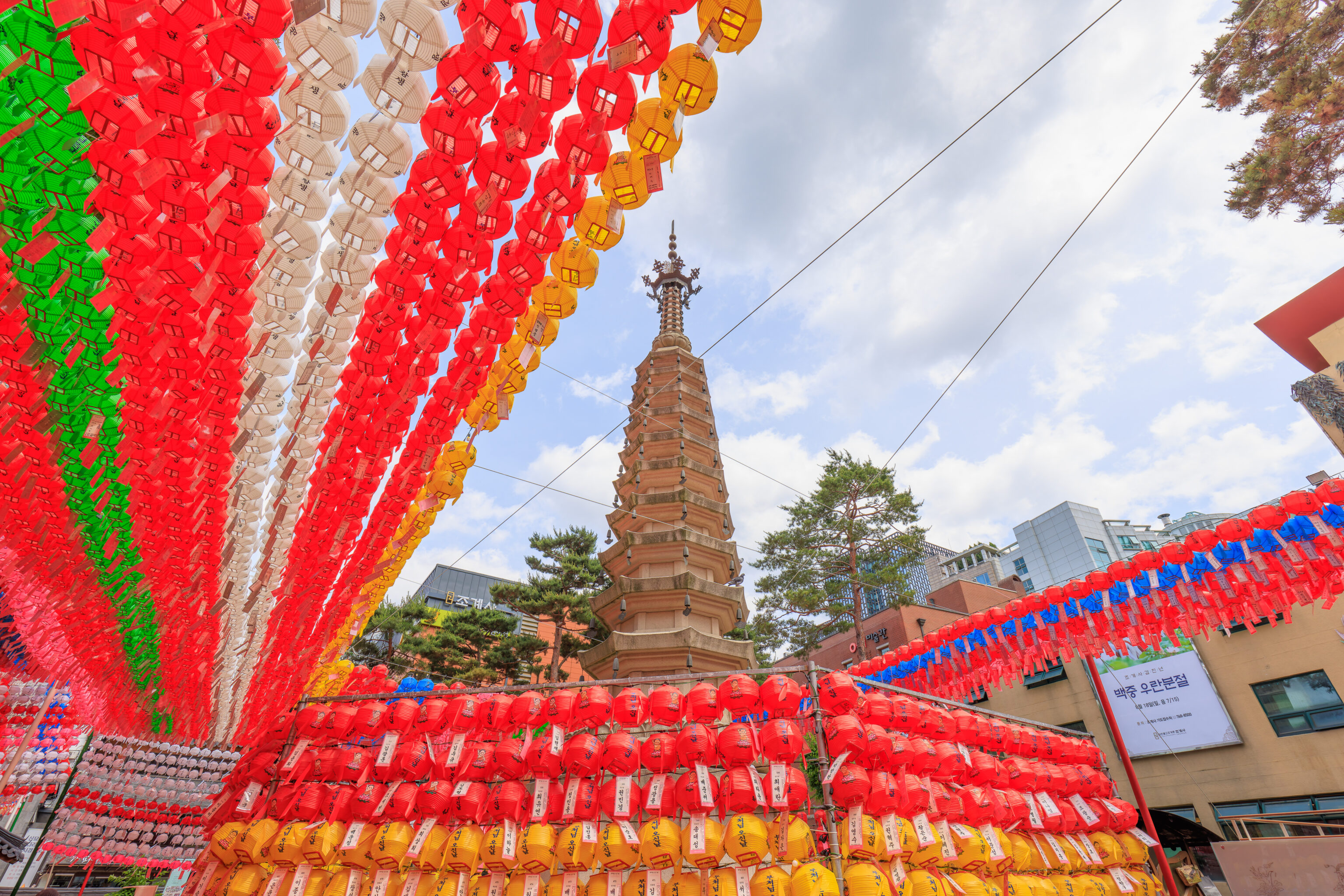

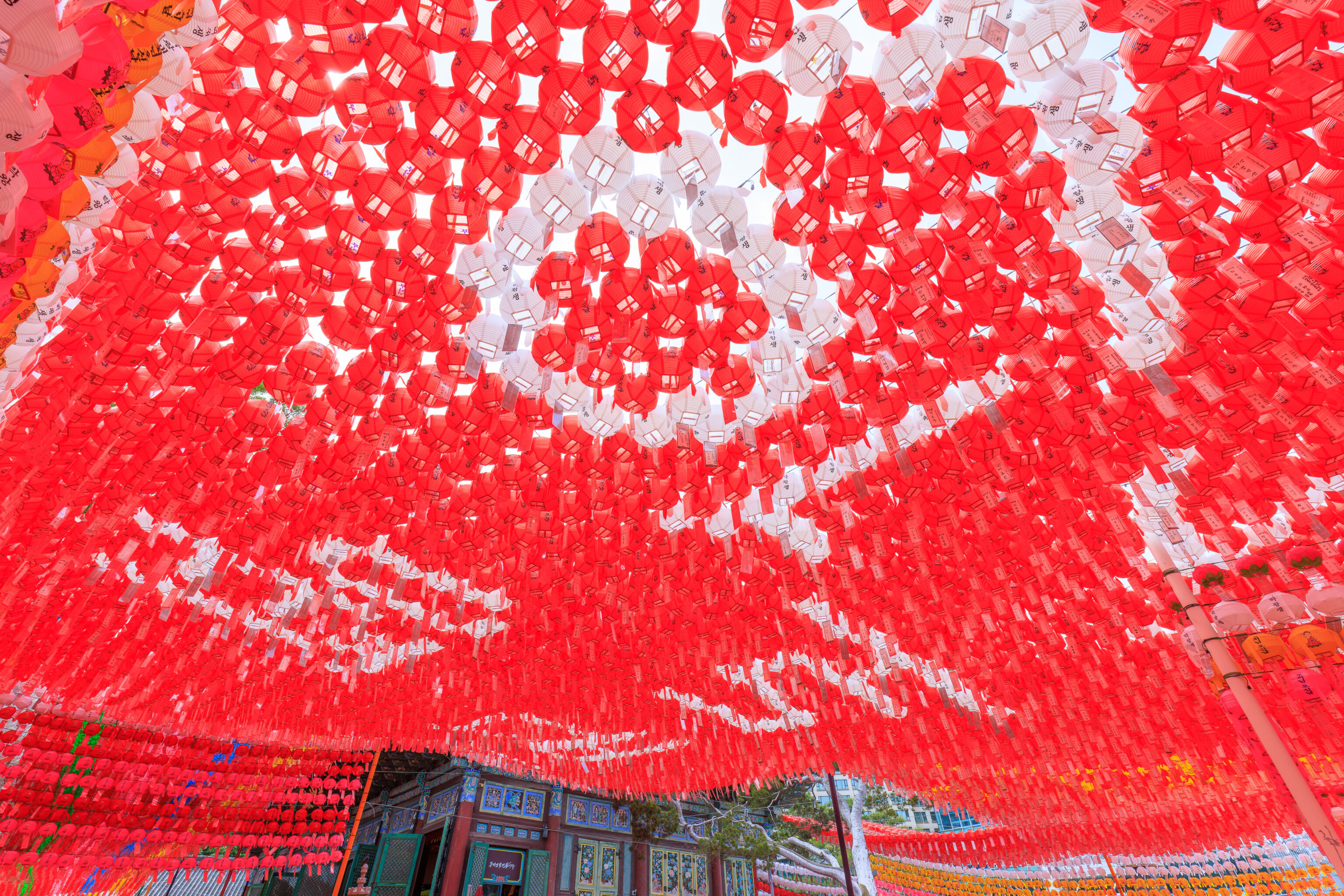
Time to go! We walked around the temple a bit more before leaving.
Myeongdong
We continued on to 명동 Myeongdong, which was many blocks to the south.

A block before reaching the Cheonggyecheon, we came across the 보신각 Bosingak. This pavilion houses a bell. There was a multilingual sign with quite a bit of text, in Korean, English, Chinese, and Japanese. The English section reads:
This bell pavilion was originally built in 1396 (the 5th year of the reign of King Taejo) in present-day Insa-dong, then the heart of Hanyang, the capital of the Joseon Dynasty (present-day Seoul), and was moved to its current location during the reign of King Taejong (1400-1418). The Bosingak Bell was rung thirty-three times to announce paru, the opening of the city gates at daybreak and twenty-eight times to announce injeong their closure at night, according to the prevailing Buddhist custom. It was also rung to warn the populace of emergencies such as fires, etc. The bell pavilion was originally a considerably larger structure (measuring 5 kan* by 4 kan), but it was destroyed and repaired many times over the years due to wars and fires, and had become a smaller structure by the late Joseon Period. It used to be called Jonggoru, Jonggak or Ingyeongjeon, but acquired its current name Bosingak in 1895 during the reign of King Gojong. In 1979, the bell pavilion was completely restored to the large-size structure seen during the reign of King Sejong. In 1985, the Old Bronze Bell of Bosingak Pavilion (Treasure No. 2) was replaced with a replica and sent to the National Museum of Korea.
Kan: a unit of measurement referring to the distance between two columns
The phrasing of the Korean section is a bit different but overall conveys the same meaning. The Chinese and Japanese text are very similar to the Korean.
There is a stone marker in front of the building. A sign explains what it is:
This square granite stone, located in front of Bosingak Pavilion, was used as the reference marker for elevation measurements during the construction of the Seoul Metropolitan Subway. It served as the benchmark for all measurements taken during the first years of the subway's construction, including the depth of the tracks, the height of the tunnels, and the height of the station buildings.
In the 1960s, Seoul's transportation infrastructure was challenged by an increasingly dense population and a growing number of vehicles. In response, a headquarters to oversee the construction of a subway system was established in June 1970. This benchmark was installed on October 30, 1970, as the first step in preparation for the construction of Seoul Subway Line 1. Measurements based on this benchmark were taken by the end of November 1970, and Line 1 was opened for public use in 1974, spanning from Seoul Station to Cheongnyangni Station. In 1979, however, the benchmark had to be moved slightly backward due to the expansion of the adjacent road, and thus lost its original function.
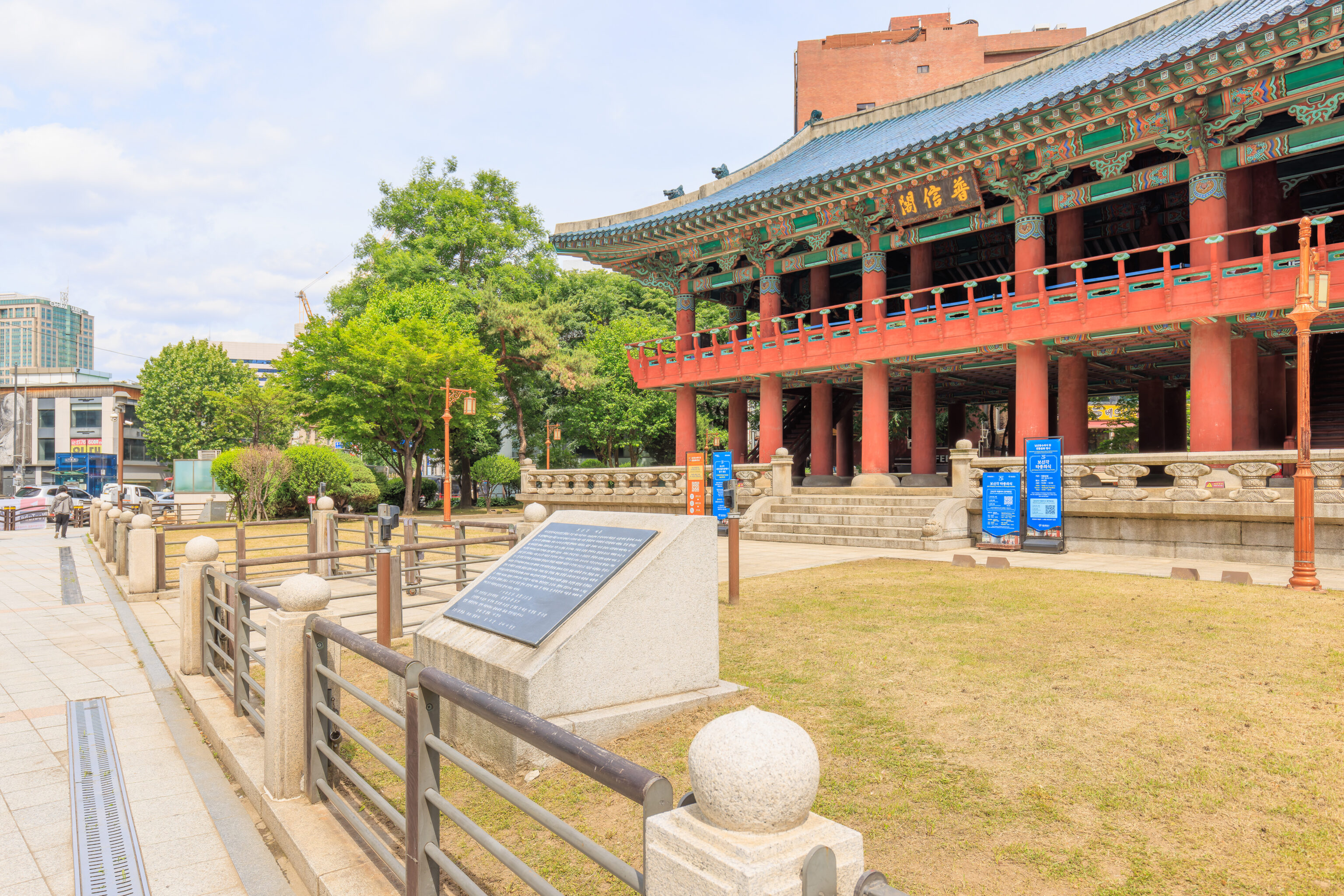
It isn’t possible to get any closer as the entire pavilion is surrounded by a fence.

The pavilion as seen from a bit further back.

We sat here on a bench for a bit to rest.

This building on the other side of the street has an interesting design. It is the Samsung Jungno Tower, owned by the chaebol‘s financial services company, Samsung Securities. Interestingly, they decided they weren’t happy with the building’s design after it was already partially built. It ended up getting redesigned but used the lower portion rather than starting over from scratch.

We continued on to reach the a bridge that crosses the Cheonggyecheon. This was the view to the east as we had been walking on the east side of the street. Although the weather was pretty mixed throughout the day, sometimes with dark overcast skies, it was pretty hot when the sun was out, like when we arrived here.

We walked down to river level to take a look. We started walking to the east on the south side of the stream.
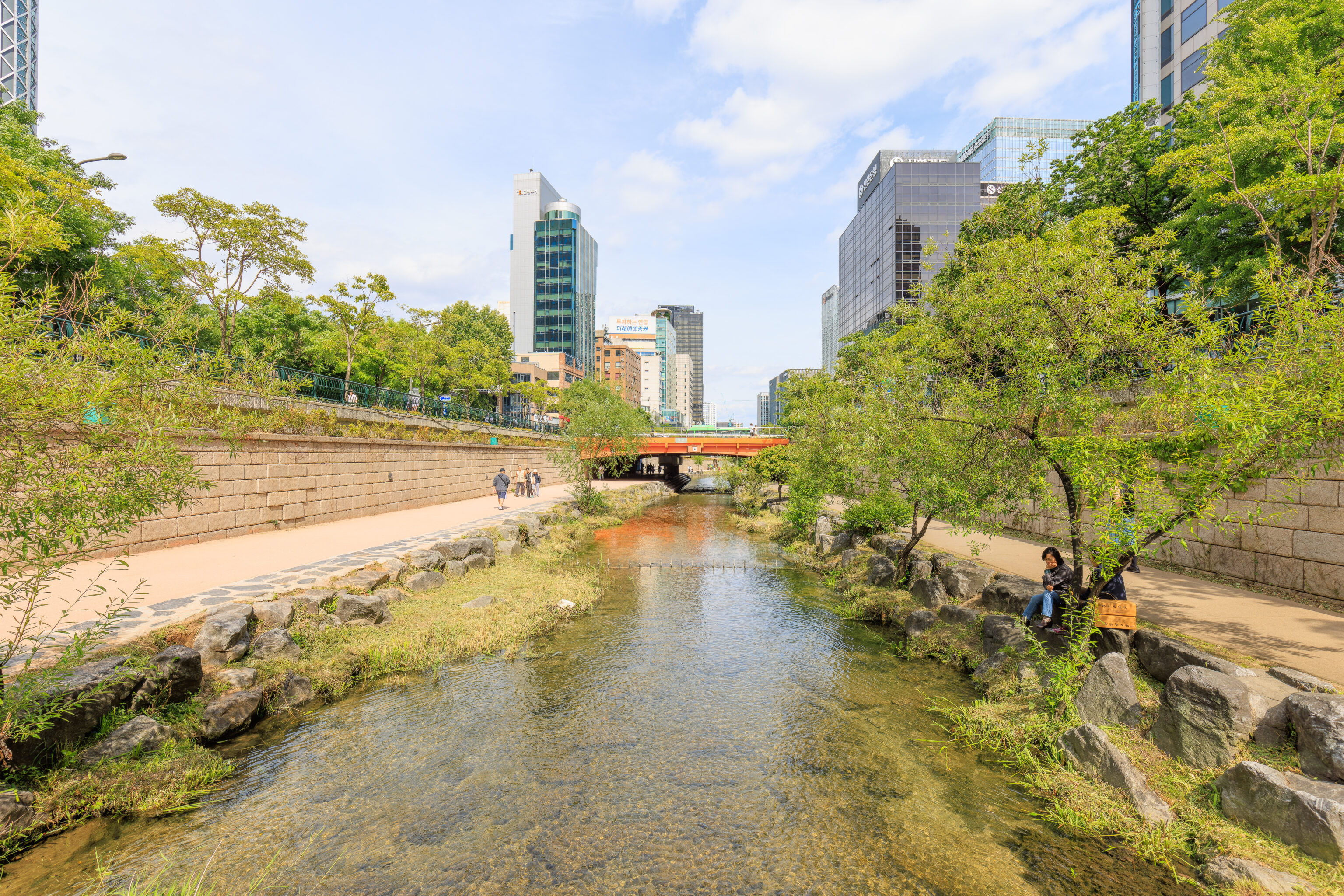
We crossed over the stream via a pedestrian bridge. This was the view to the east as we crossed.

Looking to the west, we could see the tip of the spiral sculpture at the west end of the stream.

We ascended back up to street level. This was the view to the east.
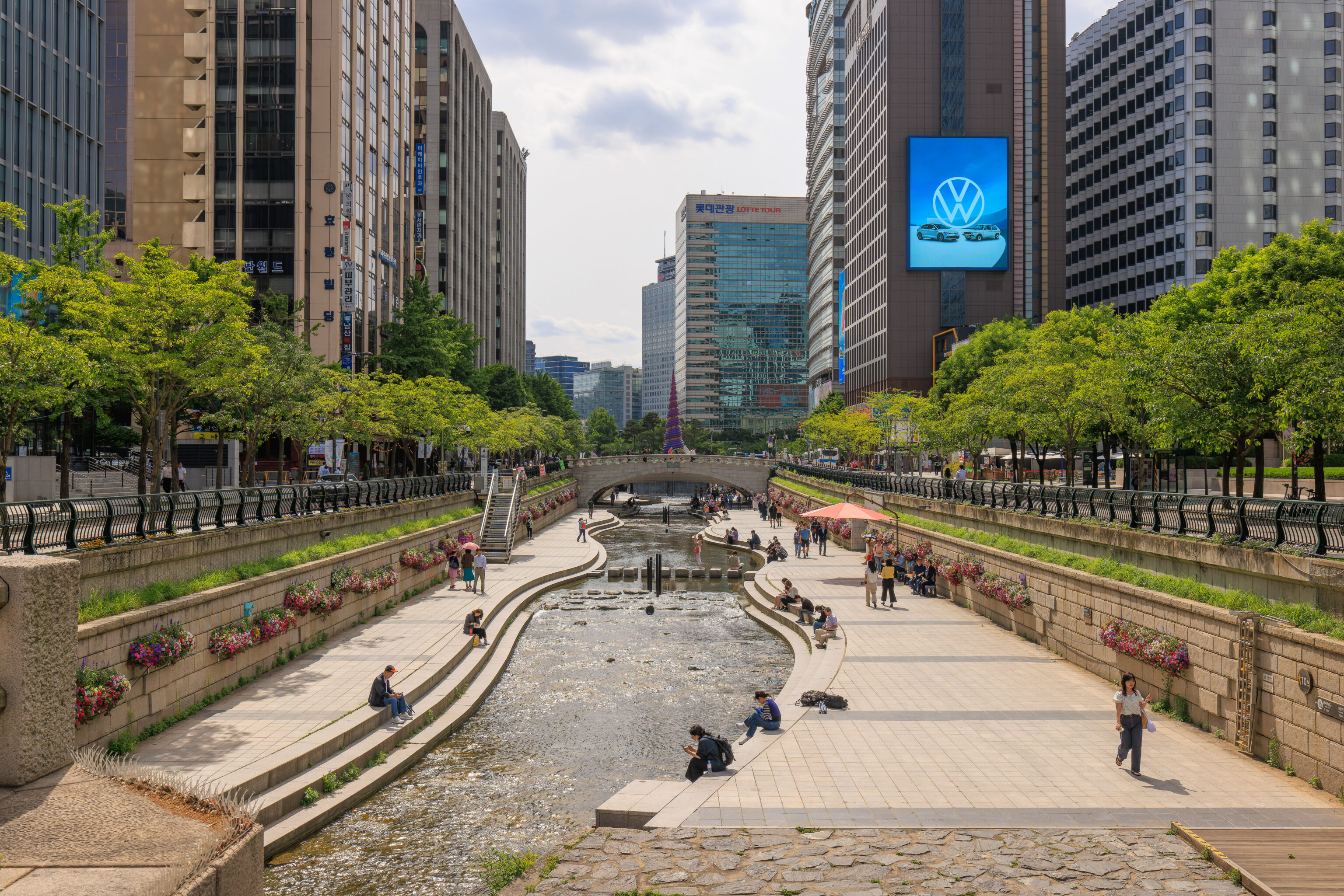
And, this was the view to the west. We had a better view of the spiral sculpture now. We didn’t go any further west as we were already there yesterday.
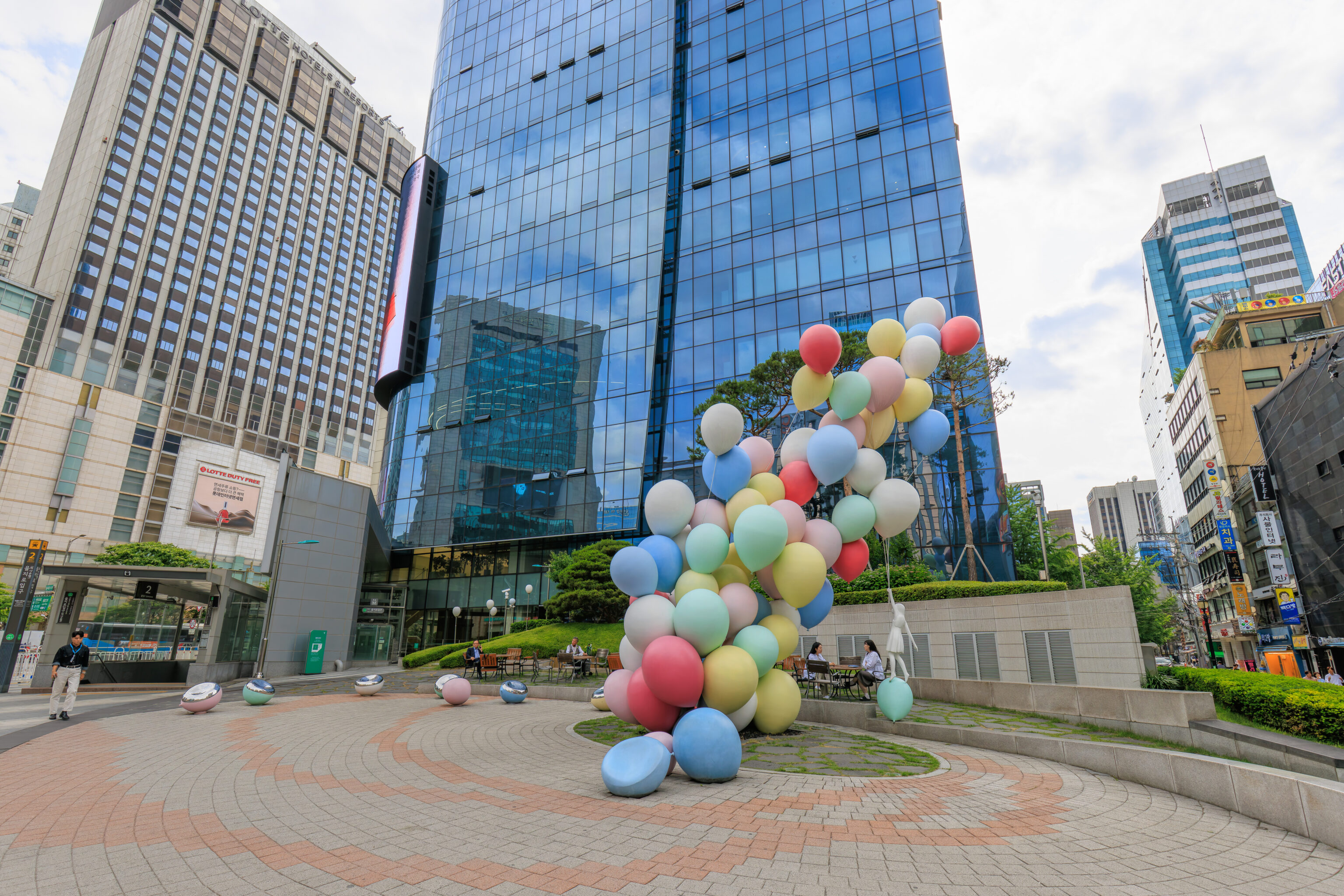
We continued walking, heading south and east. We soon reached the 을지로입구역 Euljiro 1-ga subway station, technically already in Myeongdong, though not yet in the area of interest for tourists. This balloon sculpture was at an intersection by the station. There are some balloon seats, though they were quite slippery and unpractical for actual sitting.

We decided to have bingsoo at 설빙 Sulbing, just basically around the corner from the station. We decided to have the premium strawberry bingsoo. It was very good, particularly the strawberries! There was also a triangle of cheese sticking into the top of the bingsoo. The Koreans seem pretty big on cheese, though we find cheese on bingsoo to be a weird combination.
It turns out that Sulbing is a huge bingsoo chain here in Korea. It is unlike anything we have available in the US with a huge variety of bingsoo!

As we continued further into Myeongdong, we came across a night market. It is conceptually similar to the night markets of Taipei, though with much less variety. There were many duplicate shops selling identical foods.

We did get a lamb skewer. After walking around the area for awhile, we headed back to Hongdae. As we were walking to the metro station, we happened to walk by the Le Meridien. We had considered staying at this hotel in Myeongdong but ultimately decided on the RYSE in Hongdae.

We passed by this Neon Genesis Evangelion collab as we exited the subway station. We encountered this anime recently in Hakone, Japan, where there was a large statue of EVA-01, the purple mecha from the series. This anime is a bit more than 25 years old now, so, it is surprising to see it out on the street!

We passed by this interesting little sculpture as we continued walking south to the RYSE to end our day.



One Reply to “Gyeongbokgung to Myeongdong”